Use of Technology in the Classroom - PDF
VerifiedAdded on 2021/02/20
|27
|6533
|209
AI Summary
Contribute Materials
Your contribution can guide someone’s learning journey. Share your
documents today.
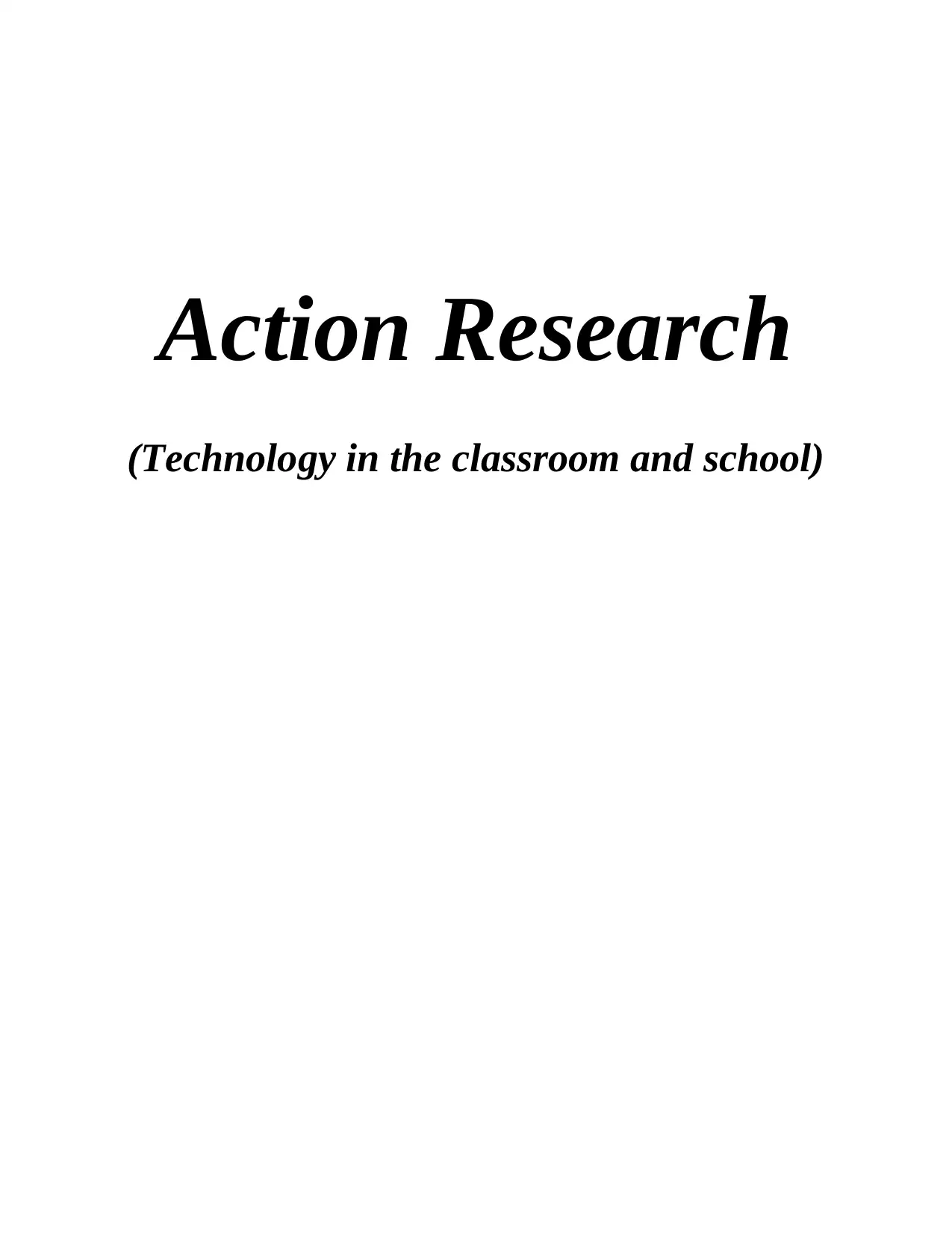
Action Research
(Technology in the classroom and school)
(Technology in the classroom and school)
Secure Best Marks with AI Grader
Need help grading? Try our AI Grader for instant feedback on your assignments.
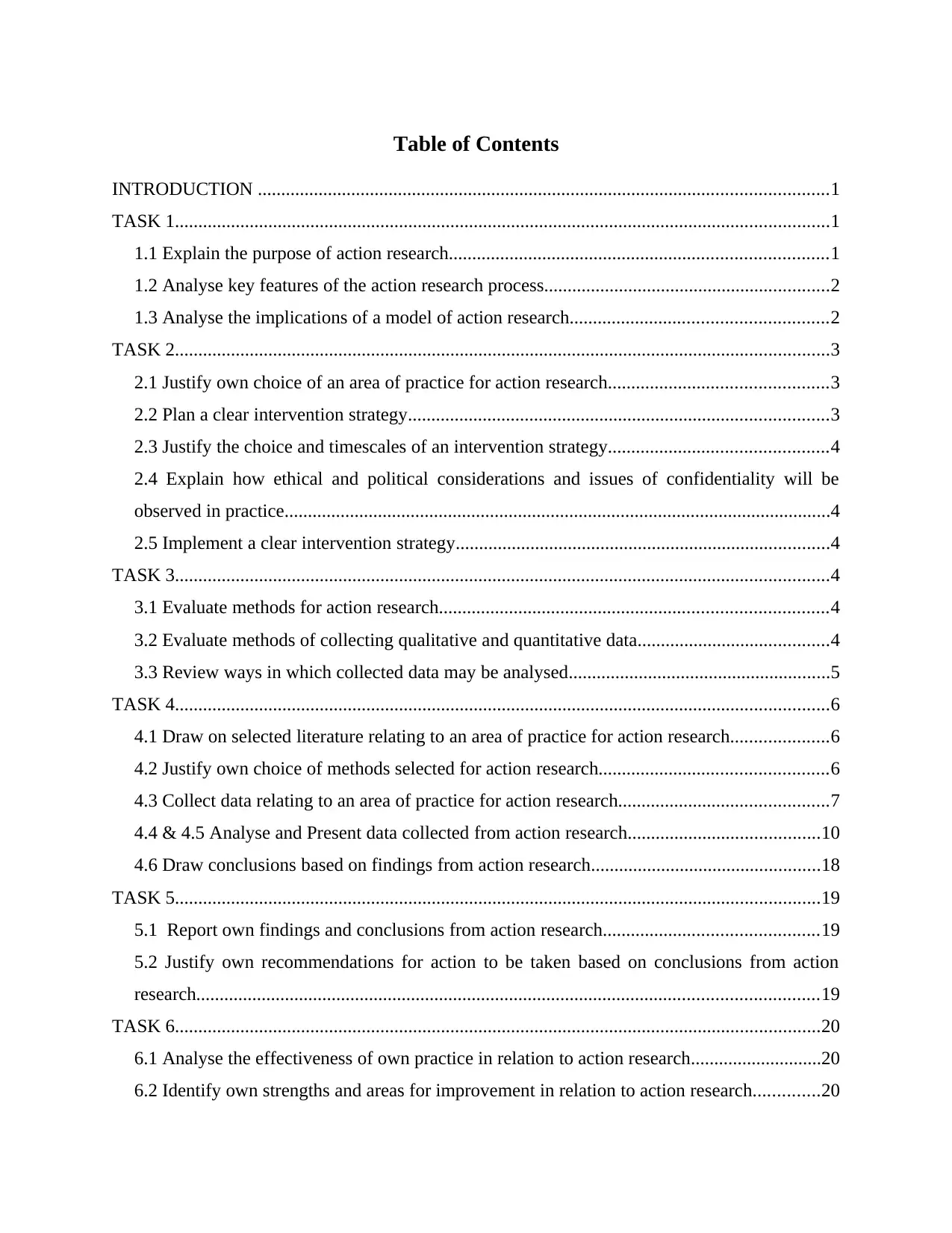
Table of Contents
INTRODUCTION ..........................................................................................................................1
TASK 1............................................................................................................................................1
1.1 Explain the purpose of action research.................................................................................1
1.2 Analyse key features of the action research process.............................................................2
1.3 Analyse the implications of a model of action research.......................................................2
TASK 2............................................................................................................................................3
2.1 Justify own choice of an area of practice for action research...............................................3
2.2 Plan a clear intervention strategy..........................................................................................3
2.3 Justify the choice and timescales of an intervention strategy...............................................4
2.4 Explain how ethical and political considerations and issues of confidentiality will be
observed in practice.....................................................................................................................4
2.5 Implement a clear intervention strategy................................................................................4
TASK 3............................................................................................................................................4
3.1 Evaluate methods for action research...................................................................................4
3.2 Evaluate methods of collecting qualitative and quantitative data.........................................4
3.3 Review ways in which collected data may be analysed........................................................5
TASK 4............................................................................................................................................6
4.1 Draw on selected literature relating to an area of practice for action research.....................6
4.2 Justify own choice of methods selected for action research.................................................6
4.3 Collect data relating to an area of practice for action research.............................................7
4.4 & 4.5 Analyse and Present data collected from action research.........................................10
4.6 Draw conclusions based on findings from action research.................................................18
TASK 5..........................................................................................................................................19
5.1 Report own findings and conclusions from action research..............................................19
5.2 Justify own recommendations for action to be taken based on conclusions from action
research.....................................................................................................................................19
TASK 6..........................................................................................................................................20
6.1 Analyse the effectiveness of own practice in relation to action research............................20
6.2 Identify own strengths and areas for improvement in relation to action research..............20
INTRODUCTION ..........................................................................................................................1
TASK 1............................................................................................................................................1
1.1 Explain the purpose of action research.................................................................................1
1.2 Analyse key features of the action research process.............................................................2
1.3 Analyse the implications of a model of action research.......................................................2
TASK 2............................................................................................................................................3
2.1 Justify own choice of an area of practice for action research...............................................3
2.2 Plan a clear intervention strategy..........................................................................................3
2.3 Justify the choice and timescales of an intervention strategy...............................................4
2.4 Explain how ethical and political considerations and issues of confidentiality will be
observed in practice.....................................................................................................................4
2.5 Implement a clear intervention strategy................................................................................4
TASK 3............................................................................................................................................4
3.1 Evaluate methods for action research...................................................................................4
3.2 Evaluate methods of collecting qualitative and quantitative data.........................................4
3.3 Review ways in which collected data may be analysed........................................................5
TASK 4............................................................................................................................................6
4.1 Draw on selected literature relating to an area of practice for action research.....................6
4.2 Justify own choice of methods selected for action research.................................................6
4.3 Collect data relating to an area of practice for action research.............................................7
4.4 & 4.5 Analyse and Present data collected from action research.........................................10
4.6 Draw conclusions based on findings from action research.................................................18
TASK 5..........................................................................................................................................19
5.1 Report own findings and conclusions from action research..............................................19
5.2 Justify own recommendations for action to be taken based on conclusions from action
research.....................................................................................................................................19
TASK 6..........................................................................................................................................20
6.1 Analyse the effectiveness of own practice in relation to action research............................20
6.2 Identify own strengths and areas for improvement in relation to action research..............20

6.3 Plan opportunities to improve own skills in action research...............................................20
CONCLUSION .............................................................................................................................21
REFERENCES .............................................................................................................................22
.......................................................................................................................................................23
CONCLUSION .............................................................................................................................21
REFERENCES .............................................................................................................................22
.......................................................................................................................................................23
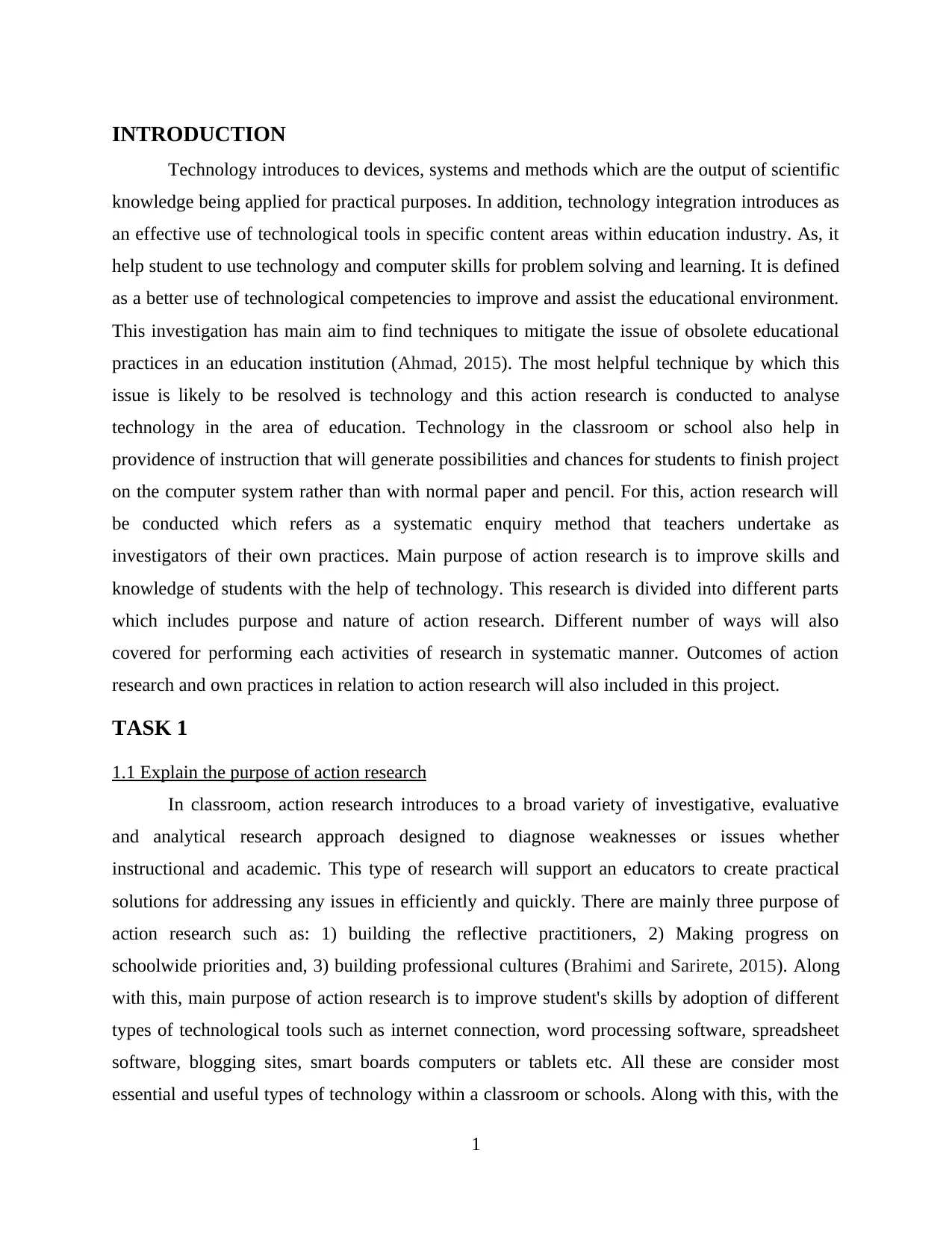
INTRODUCTION
Technology introduces to devices, systems and methods which are the output of scientific
knowledge being applied for practical purposes. In addition, technology integration introduces as
an effective use of technological tools in specific content areas within education industry. As, it
help student to use technology and computer skills for problem solving and learning. It is defined
as a better use of technological competencies to improve and assist the educational environment.
This investigation has main aim to find techniques to mitigate the issue of obsolete educational
practices in an education institution (Ahmad, 2015). The most helpful technique by which this
issue is likely to be resolved is technology and this action research is conducted to analyse
technology in the area of education. Technology in the classroom or school also help in
providence of instruction that will generate possibilities and chances for students to finish project
on the computer system rather than with normal paper and pencil. For this, action research will
be conducted which refers as a systematic enquiry method that teachers undertake as
investigators of their own practices. Main purpose of action research is to improve skills and
knowledge of students with the help of technology. This research is divided into different parts
which includes purpose and nature of action research. Different number of ways will also
covered for performing each activities of research in systematic manner. Outcomes of action
research and own practices in relation to action research will also included in this project.
TASK 1
1.1 Explain the purpose of action research
In classroom, action research introduces to a broad variety of investigative, evaluative
and analytical research approach designed to diagnose weaknesses or issues whether
instructional and academic. This type of research will support an educators to create practical
solutions for addressing any issues in efficiently and quickly. There are mainly three purpose of
action research such as: 1) building the reflective practitioners, 2) Making progress on
schoolwide priorities and, 3) building professional cultures (Brahimi and Sarirete, 2015). Along
with this, main purpose of action research is to improve student's skills by adoption of different
types of technological tools such as internet connection, word processing software, spreadsheet
software, blogging sites, smart boards computers or tablets etc. All these are consider most
essential and useful types of technology within a classroom or schools. Along with this, with the
1
Technology introduces to devices, systems and methods which are the output of scientific
knowledge being applied for practical purposes. In addition, technology integration introduces as
an effective use of technological tools in specific content areas within education industry. As, it
help student to use technology and computer skills for problem solving and learning. It is defined
as a better use of technological competencies to improve and assist the educational environment.
This investigation has main aim to find techniques to mitigate the issue of obsolete educational
practices in an education institution (Ahmad, 2015). The most helpful technique by which this
issue is likely to be resolved is technology and this action research is conducted to analyse
technology in the area of education. Technology in the classroom or school also help in
providence of instruction that will generate possibilities and chances for students to finish project
on the computer system rather than with normal paper and pencil. For this, action research will
be conducted which refers as a systematic enquiry method that teachers undertake as
investigators of their own practices. Main purpose of action research is to improve skills and
knowledge of students with the help of technology. This research is divided into different parts
which includes purpose and nature of action research. Different number of ways will also
covered for performing each activities of research in systematic manner. Outcomes of action
research and own practices in relation to action research will also included in this project.
TASK 1
1.1 Explain the purpose of action research
In classroom, action research introduces to a broad variety of investigative, evaluative
and analytical research approach designed to diagnose weaknesses or issues whether
instructional and academic. This type of research will support an educators to create practical
solutions for addressing any issues in efficiently and quickly. There are mainly three purpose of
action research such as: 1) building the reflective practitioners, 2) Making progress on
schoolwide priorities and, 3) building professional cultures (Brahimi and Sarirete, 2015). Along
with this, main purpose of action research is to improve student's skills by adoption of different
types of technological tools such as internet connection, word processing software, spreadsheet
software, blogging sites, smart boards computers or tablets etc. All these are consider most
essential and useful types of technology within a classroom or schools. Along with this, with the
1
Secure Best Marks with AI Grader
Need help grading? Try our AI Grader for instant feedback on your assignments.

help of all technology, teacher can easily improve knowledge and skills of their student within
education industry.
1.2 Analyse key features of the action research process
Action research introduces as a systematic multi-staged cyclical process or activities,
which seeks to enhance practice via the implementation of incremental and informed change.
There are some key features or characteristic of action research process which are determined as
under:
Step 1: Selecting a focus: It introduces as a first process in conducting action research is
to determine and explain the focus of their research. Examination of the school, students,
programs and instructional practice introduces as a main features of this step. As it will help a
teacher to analysis needs and wants of students within classroom.
Step 2: Collecting data: It is second step which involved in doing action research
includes accumulating information to use in answering research questions. This information
may consists of instructor made surveys as well as standardized test data. Main feature of this
step is interview and survey (Delgado and et. al., 2015). Gathered information may consist of
student observation, portfolio and many other sources of information.
Step 3: Analyzing and interpreting data: After identifying focus of students and
collection of data, teacher will require to determine and make interpretations from their
materials. In this, tutor want to summarize the information about the importance of technology in
classroom.
Step 4: Taking action: It is a last step of action research which includes to making an
effective decision regarding action research and determining next possible actions. Main feature
of this step is to surveyed the students, supervisors, teachers and know exactly how to fix the
issue.
1.3 Analyse the implications of a model of action research
There are different models of action research such as Kurt Lewin's model, Dave Ebbutt's
model, Kemmis and McTaggart's model, Jean McNiff's model, John Elliott's model etc. All these
are identify effective and essential model of action research which will help in education industry
by implementing technology (Hwang, Lai and Wang, 2015). As technology will assist a teacher
2
education industry.
1.2 Analyse key features of the action research process
Action research introduces as a systematic multi-staged cyclical process or activities,
which seeks to enhance practice via the implementation of incremental and informed change.
There are some key features or characteristic of action research process which are determined as
under:
Step 1: Selecting a focus: It introduces as a first process in conducting action research is
to determine and explain the focus of their research. Examination of the school, students,
programs and instructional practice introduces as a main features of this step. As it will help a
teacher to analysis needs and wants of students within classroom.
Step 2: Collecting data: It is second step which involved in doing action research
includes accumulating information to use in answering research questions. This information
may consists of instructor made surveys as well as standardized test data. Main feature of this
step is interview and survey (Delgado and et. al., 2015). Gathered information may consist of
student observation, portfolio and many other sources of information.
Step 3: Analyzing and interpreting data: After identifying focus of students and
collection of data, teacher will require to determine and make interpretations from their
materials. In this, tutor want to summarize the information about the importance of technology in
classroom.
Step 4: Taking action: It is a last step of action research which includes to making an
effective decision regarding action research and determining next possible actions. Main feature
of this step is to surveyed the students, supervisors, teachers and know exactly how to fix the
issue.
1.3 Analyse the implications of a model of action research
There are different models of action research such as Kurt Lewin's model, Dave Ebbutt's
model, Kemmis and McTaggart's model, Jean McNiff's model, John Elliott's model etc. All these
are identify effective and essential model of action research which will help in education industry
by implementing technology (Hwang, Lai and Wang, 2015). As technology will assist a teacher
2
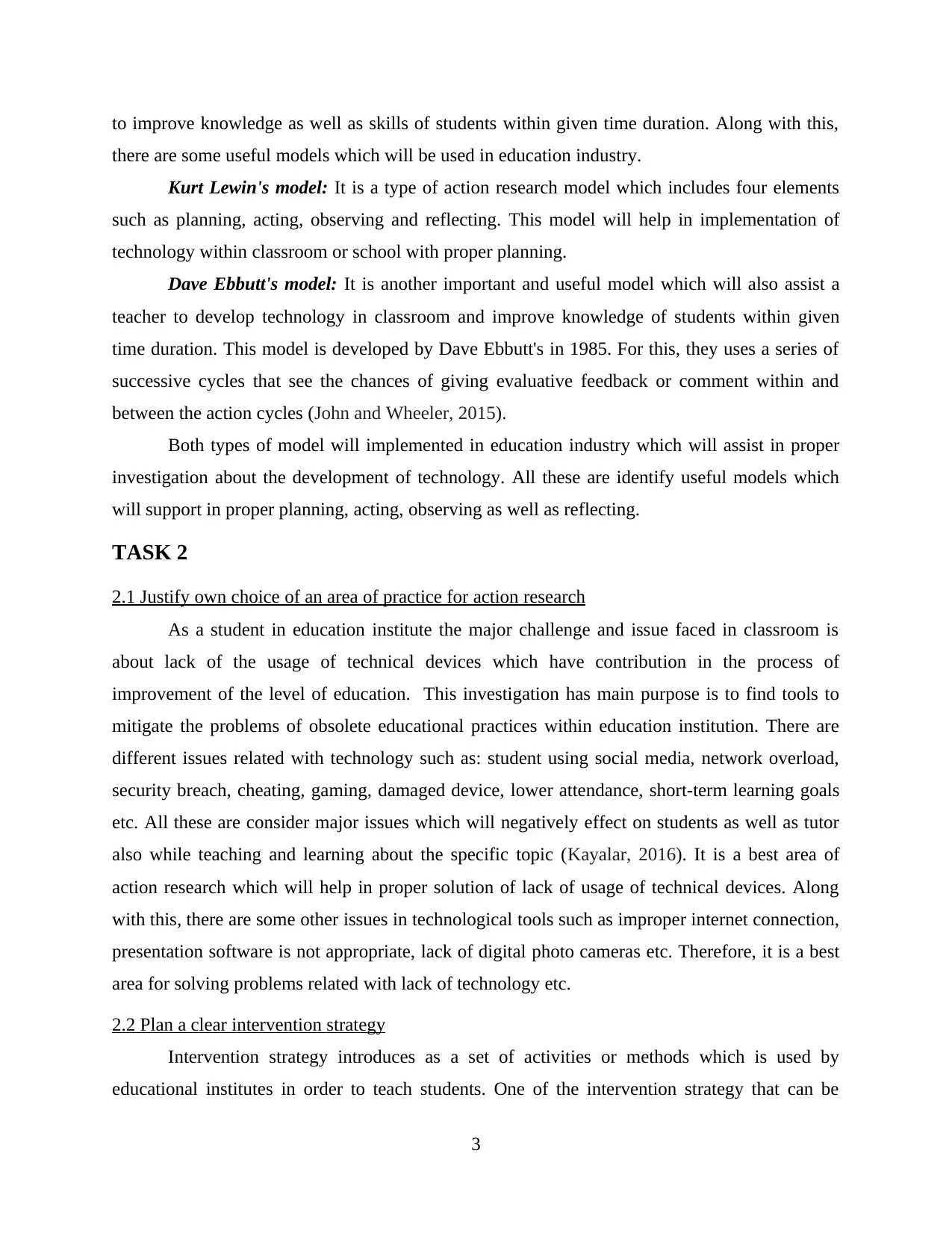
to improve knowledge as well as skills of students within given time duration. Along with this,
there are some useful models which will be used in education industry.
Kurt Lewin's model: It is a type of action research model which includes four elements
such as planning, acting, observing and reflecting. This model will help in implementation of
technology within classroom or school with proper planning.
Dave Ebbutt's model: It is another important and useful model which will also assist a
teacher to develop technology in classroom and improve knowledge of students within given
time duration. This model is developed by Dave Ebbutt's in 1985. For this, they uses a series of
successive cycles that see the chances of giving evaluative feedback or comment within and
between the action cycles (John and Wheeler, 2015).
Both types of model will implemented in education industry which will assist in proper
investigation about the development of technology. All these are identify useful models which
will support in proper planning, acting, observing as well as reflecting.
TASK 2
2.1 Justify own choice of an area of practice for action research
As a student in education institute the major challenge and issue faced in classroom is
about lack of the usage of technical devices which have contribution in the process of
improvement of the level of education. This investigation has main purpose is to find tools to
mitigate the problems of obsolete educational practices within education institution. There are
different issues related with technology such as: student using social media, network overload,
security breach, cheating, gaming, damaged device, lower attendance, short-term learning goals
etc. All these are consider major issues which will negatively effect on students as well as tutor
also while teaching and learning about the specific topic (Kayalar, 2016). It is a best area of
action research which will help in proper solution of lack of usage of technical devices. Along
with this, there are some other issues in technological tools such as improper internet connection,
presentation software is not appropriate, lack of digital photo cameras etc. Therefore, it is a best
area for solving problems related with lack of technology etc.
2.2 Plan a clear intervention strategy
Intervention strategy introduces as a set of activities or methods which is used by
educational institutes in order to teach students. One of the intervention strategy that can be
3
there are some useful models which will be used in education industry.
Kurt Lewin's model: It is a type of action research model which includes four elements
such as planning, acting, observing and reflecting. This model will help in implementation of
technology within classroom or school with proper planning.
Dave Ebbutt's model: It is another important and useful model which will also assist a
teacher to develop technology in classroom and improve knowledge of students within given
time duration. This model is developed by Dave Ebbutt's in 1985. For this, they uses a series of
successive cycles that see the chances of giving evaluative feedback or comment within and
between the action cycles (John and Wheeler, 2015).
Both types of model will implemented in education industry which will assist in proper
investigation about the development of technology. All these are identify useful models which
will support in proper planning, acting, observing as well as reflecting.
TASK 2
2.1 Justify own choice of an area of practice for action research
As a student in education institute the major challenge and issue faced in classroom is
about lack of the usage of technical devices which have contribution in the process of
improvement of the level of education. This investigation has main purpose is to find tools to
mitigate the problems of obsolete educational practices within education institution. There are
different issues related with technology such as: student using social media, network overload,
security breach, cheating, gaming, damaged device, lower attendance, short-term learning goals
etc. All these are consider major issues which will negatively effect on students as well as tutor
also while teaching and learning about the specific topic (Kayalar, 2016). It is a best area of
action research which will help in proper solution of lack of usage of technical devices. Along
with this, there are some other issues in technological tools such as improper internet connection,
presentation software is not appropriate, lack of digital photo cameras etc. Therefore, it is a best
area for solving problems related with lack of technology etc.
2.2 Plan a clear intervention strategy
Intervention strategy introduces as a set of activities or methods which is used by
educational institutes in order to teach students. One of the intervention strategy that can be
3
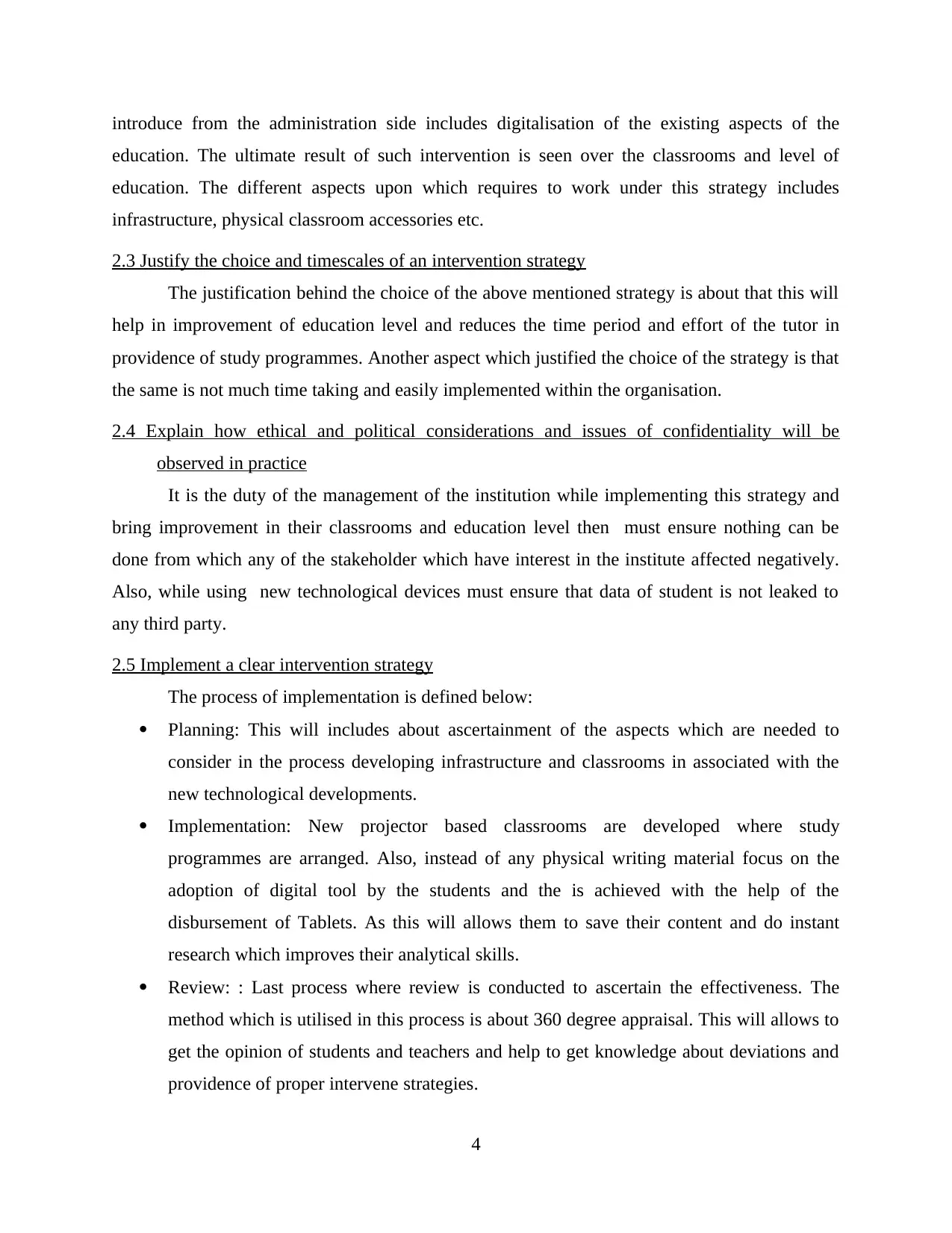
introduce from the administration side includes digitalisation of the existing aspects of the
education. The ultimate result of such intervention is seen over the classrooms and level of
education. The different aspects upon which requires to work under this strategy includes
infrastructure, physical classroom accessories etc.
2.3 Justify the choice and timescales of an intervention strategy
The justification behind the choice of the above mentioned strategy is about that this will
help in improvement of education level and reduces the time period and effort of the tutor in
providence of study programmes. Another aspect which justified the choice of the strategy is that
the same is not much time taking and easily implemented within the organisation.
2.4 Explain how ethical and political considerations and issues of confidentiality will be
observed in practice
It is the duty of the management of the institution while implementing this strategy and
bring improvement in their classrooms and education level then must ensure nothing can be
done from which any of the stakeholder which have interest in the institute affected negatively.
Also, while using new technological devices must ensure that data of student is not leaked to
any third party.
2.5 Implement a clear intervention strategy
The process of implementation is defined below:
Planning: This will includes about ascertainment of the aspects which are needed to
consider in the process developing infrastructure and classrooms in associated with the
new technological developments.
Implementation: New projector based classrooms are developed where study
programmes are arranged. Also, instead of any physical writing material focus on the
adoption of digital tool by the students and the is achieved with the help of the
disbursement of Tablets. As this will allows them to save their content and do instant
research which improves their analytical skills.
Review: : Last process where review is conducted to ascertain the effectiveness. The
method which is utilised in this process is about 360 degree appraisal. This will allows to
get the opinion of students and teachers and help to get knowledge about deviations and
providence of proper intervene strategies.
4
education. The ultimate result of such intervention is seen over the classrooms and level of
education. The different aspects upon which requires to work under this strategy includes
infrastructure, physical classroom accessories etc.
2.3 Justify the choice and timescales of an intervention strategy
The justification behind the choice of the above mentioned strategy is about that this will
help in improvement of education level and reduces the time period and effort of the tutor in
providence of study programmes. Another aspect which justified the choice of the strategy is that
the same is not much time taking and easily implemented within the organisation.
2.4 Explain how ethical and political considerations and issues of confidentiality will be
observed in practice
It is the duty of the management of the institution while implementing this strategy and
bring improvement in their classrooms and education level then must ensure nothing can be
done from which any of the stakeholder which have interest in the institute affected negatively.
Also, while using new technological devices must ensure that data of student is not leaked to
any third party.
2.5 Implement a clear intervention strategy
The process of implementation is defined below:
Planning: This will includes about ascertainment of the aspects which are needed to
consider in the process developing infrastructure and classrooms in associated with the
new technological developments.
Implementation: New projector based classrooms are developed where study
programmes are arranged. Also, instead of any physical writing material focus on the
adoption of digital tool by the students and the is achieved with the help of the
disbursement of Tablets. As this will allows them to save their content and do instant
research which improves their analytical skills.
Review: : Last process where review is conducted to ascertain the effectiveness. The
method which is utilised in this process is about 360 degree appraisal. This will allows to
get the opinion of students and teachers and help to get knowledge about deviations and
providence of proper intervene strategies.
4
Paraphrase This Document
Need a fresh take? Get an instant paraphrase of this document with our AI Paraphraser
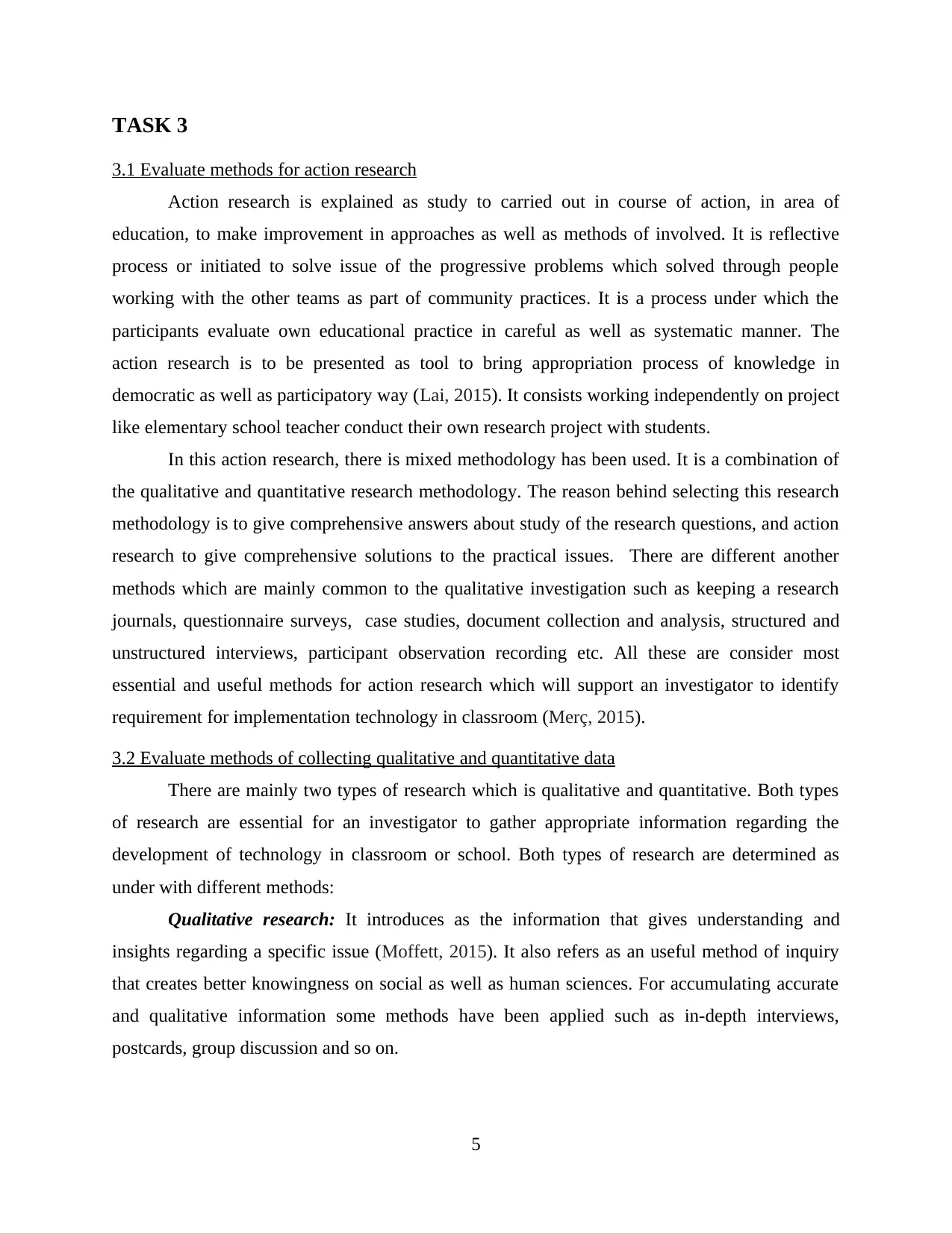
TASK 3
3.1 Evaluate methods for action research
Action research is explained as study to carried out in course of action, in area of
education, to make improvement in approaches as well as methods of involved. It is reflective
process or initiated to solve issue of the progressive problems which solved through people
working with the other teams as part of community practices. It is a process under which the
participants evaluate own educational practice in careful as well as systematic manner. The
action research is to be presented as tool to bring appropriation process of knowledge in
democratic as well as participatory way (Lai, 2015). It consists working independently on project
like elementary school teacher conduct their own research project with students.
In this action research, there is mixed methodology has been used. It is a combination of
the qualitative and quantitative research methodology. The reason behind selecting this research
methodology is to give comprehensive answers about study of the research questions, and action
research to give comprehensive solutions to the practical issues. There are different another
methods which are mainly common to the qualitative investigation such as keeping a research
journals, questionnaire surveys, case studies, document collection and analysis, structured and
unstructured interviews, participant observation recording etc. All these are consider most
essential and useful methods for action research which will support an investigator to identify
requirement for implementation technology in classroom (Merç, 2015).
3.2 Evaluate methods of collecting qualitative and quantitative data
There are mainly two types of research which is qualitative and quantitative. Both types
of research are essential for an investigator to gather appropriate information regarding the
development of technology in classroom or school. Both types of research are determined as
under with different methods:
Qualitative research: It introduces as the information that gives understanding and
insights regarding a specific issue (Moffett, 2015). It also refers as an useful method of inquiry
that creates better knowingness on social as well as human sciences. For accumulating accurate
and qualitative information some methods have been applied such as in-depth interviews,
postcards, group discussion and so on.
5
3.1 Evaluate methods for action research
Action research is explained as study to carried out in course of action, in area of
education, to make improvement in approaches as well as methods of involved. It is reflective
process or initiated to solve issue of the progressive problems which solved through people
working with the other teams as part of community practices. It is a process under which the
participants evaluate own educational practice in careful as well as systematic manner. The
action research is to be presented as tool to bring appropriation process of knowledge in
democratic as well as participatory way (Lai, 2015). It consists working independently on project
like elementary school teacher conduct their own research project with students.
In this action research, there is mixed methodology has been used. It is a combination of
the qualitative and quantitative research methodology. The reason behind selecting this research
methodology is to give comprehensive answers about study of the research questions, and action
research to give comprehensive solutions to the practical issues. There are different another
methods which are mainly common to the qualitative investigation such as keeping a research
journals, questionnaire surveys, case studies, document collection and analysis, structured and
unstructured interviews, participant observation recording etc. All these are consider most
essential and useful methods for action research which will support an investigator to identify
requirement for implementation technology in classroom (Merç, 2015).
3.2 Evaluate methods of collecting qualitative and quantitative data
There are mainly two types of research which is qualitative and quantitative. Both types
of research are essential for an investigator to gather appropriate information regarding the
development of technology in classroom or school. Both types of research are determined as
under with different methods:
Qualitative research: It introduces as the information that gives understanding and
insights regarding a specific issue (Moffett, 2015). It also refers as an useful method of inquiry
that creates better knowingness on social as well as human sciences. For accumulating accurate
and qualitative information some methods have been applied such as in-depth interviews,
postcards, group discussion and so on.
5
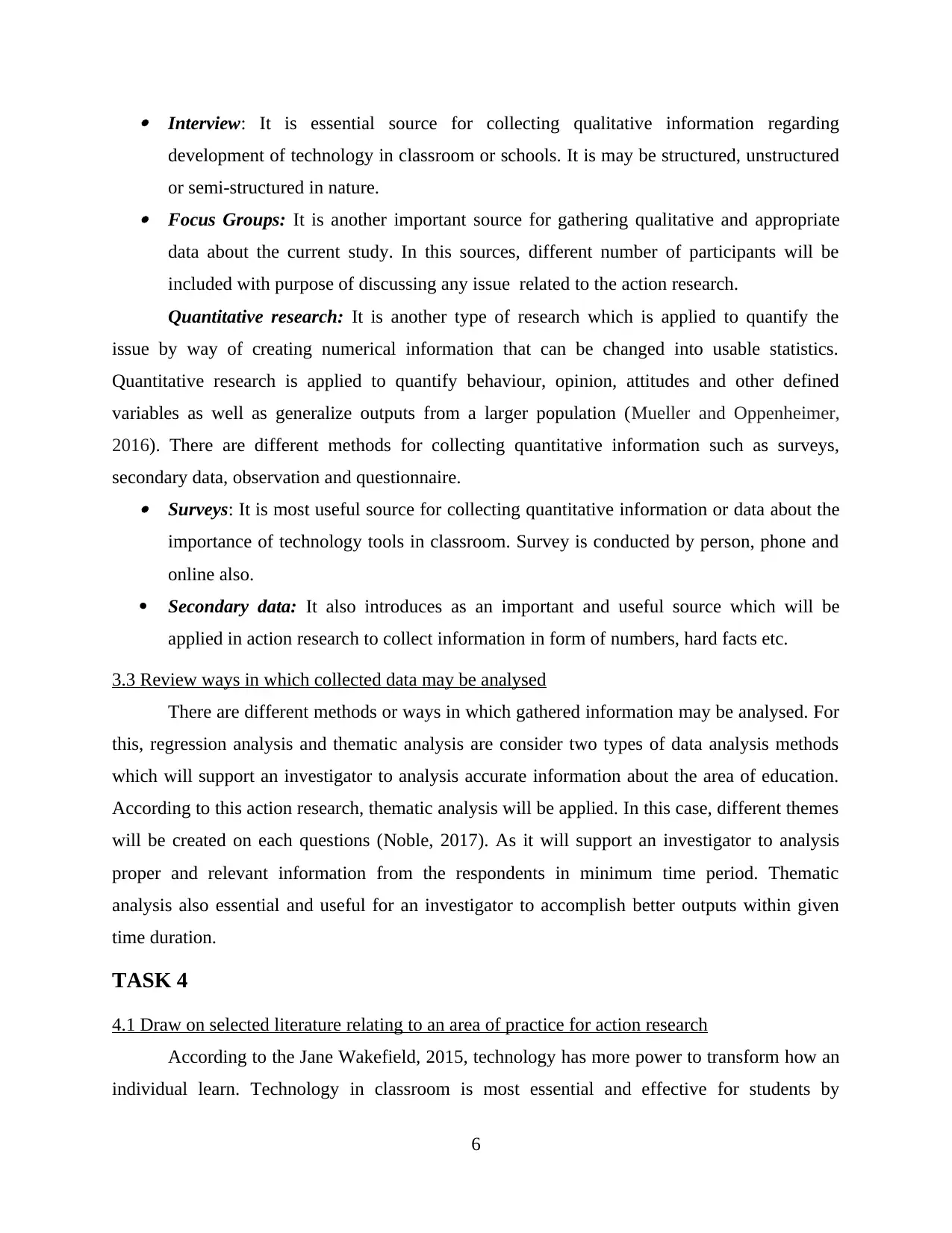
Interview: It is essential source for collecting qualitative information regarding
development of technology in classroom or schools. It is may be structured, unstructured
or semi-structured in nature. Focus Groups: It is another important source for gathering qualitative and appropriate
data about the current study. In this sources, different number of participants will be
included with purpose of discussing any issue related to the action research.
Quantitative research: It is another type of research which is applied to quantify the
issue by way of creating numerical information that can be changed into usable statistics.
Quantitative research is applied to quantify behaviour, opinion, attitudes and other defined
variables as well as generalize outputs from a larger population (Mueller and Oppenheimer,
2016). There are different methods for collecting quantitative information such as surveys,
secondary data, observation and questionnaire. Surveys: It is most useful source for collecting quantitative information or data about the
importance of technology tools in classroom. Survey is conducted by person, phone and
online also.
Secondary data: It also introduces as an important and useful source which will be
applied in action research to collect information in form of numbers, hard facts etc.
3.3 Review ways in which collected data may be analysed
There are different methods or ways in which gathered information may be analysed. For
this, regression analysis and thematic analysis are consider two types of data analysis methods
which will support an investigator to analysis accurate information about the area of education.
According to this action research, thematic analysis will be applied. In this case, different themes
will be created on each questions (Noble, 2017). As it will support an investigator to analysis
proper and relevant information from the respondents in minimum time period. Thematic
analysis also essential and useful for an investigator to accomplish better outputs within given
time duration.
TASK 4
4.1 Draw on selected literature relating to an area of practice for action research
According to the Jane Wakefield, 2015, technology has more power to transform how an
individual learn. Technology in classroom is most essential and effective for students by
6
development of technology in classroom or schools. It is may be structured, unstructured
or semi-structured in nature. Focus Groups: It is another important source for gathering qualitative and appropriate
data about the current study. In this sources, different number of participants will be
included with purpose of discussing any issue related to the action research.
Quantitative research: It is another type of research which is applied to quantify the
issue by way of creating numerical information that can be changed into usable statistics.
Quantitative research is applied to quantify behaviour, opinion, attitudes and other defined
variables as well as generalize outputs from a larger population (Mueller and Oppenheimer,
2016). There are different methods for collecting quantitative information such as surveys,
secondary data, observation and questionnaire. Surveys: It is most useful source for collecting quantitative information or data about the
importance of technology tools in classroom. Survey is conducted by person, phone and
online also.
Secondary data: It also introduces as an important and useful source which will be
applied in action research to collect information in form of numbers, hard facts etc.
3.3 Review ways in which collected data may be analysed
There are different methods or ways in which gathered information may be analysed. For
this, regression analysis and thematic analysis are consider two types of data analysis methods
which will support an investigator to analysis accurate information about the area of education.
According to this action research, thematic analysis will be applied. In this case, different themes
will be created on each questions (Noble, 2017). As it will support an investigator to analysis
proper and relevant information from the respondents in minimum time period. Thematic
analysis also essential and useful for an investigator to accomplish better outputs within given
time duration.
TASK 4
4.1 Draw on selected literature relating to an area of practice for action research
According to the Jane Wakefield, 2015, technology has more power to transform how an
individual learn. Technology in classroom is most essential and effective for students by
6

improving its learning and technical skills (Nunan and Richards, 2015). There are various
number of technological tools such as computers or tablets, word processing software, internet
connection, smart boards etc. All these are identify main technologies in classroom and help a
teachers to teach their students easily.
4.2 Justify own choice of methods selected for action research
There are different methods which will be applied for identifying any issues in classroom
about the technology. Some important and useful methods for action research will be determined
as under:
Document Collection: For collecting appropriate data regarding the specific area of
action research, there are two methods for collecting data including, primary and secondary. For
gathering primary information, questionnaire will be prepared by researcher (Sharma and et. al.,
2015). As this method of data collection will support an investigator by providing reliable and
accurate data. On the other hand, secondary method is another type of data collection which
includes different sources such as books, magazines, publication research and articles relevant to
the action research. All these sources help an investigator to gather detailed and in-depth
information regarding the research.
Questionnaire: It introduces as an important instrument of primary research which will
support a researcher to gather reliable data regarding the improvement in technology system
within education institutes. This instrument of primary research consist series of questions for the
aim of collecting information or data from respondents.
Sampling: The main motive of survey investigation is to explain the features of a
population gathering information from a sample (Thomas and Muñoz, 2016). There are two
types of sampling method including probability and non-probability. According to action
research, convenience sampling as a type of non-probability sampling will be applied by
researcher. As this method help an investigator by saving its time, cost and resources. With the
help of convenience sampling, 30 teachers of faculties within an education institute will be
selected.
4.3 Collect data relating to an area of practice for action research
Questionnaire
Q1) Do you think technology can play an important role in the area of education?
7
number of technological tools such as computers or tablets, word processing software, internet
connection, smart boards etc. All these are identify main technologies in classroom and help a
teachers to teach their students easily.
4.2 Justify own choice of methods selected for action research
There are different methods which will be applied for identifying any issues in classroom
about the technology. Some important and useful methods for action research will be determined
as under:
Document Collection: For collecting appropriate data regarding the specific area of
action research, there are two methods for collecting data including, primary and secondary. For
gathering primary information, questionnaire will be prepared by researcher (Sharma and et. al.,
2015). As this method of data collection will support an investigator by providing reliable and
accurate data. On the other hand, secondary method is another type of data collection which
includes different sources such as books, magazines, publication research and articles relevant to
the action research. All these sources help an investigator to gather detailed and in-depth
information regarding the research.
Questionnaire: It introduces as an important instrument of primary research which will
support a researcher to gather reliable data regarding the improvement in technology system
within education institutes. This instrument of primary research consist series of questions for the
aim of collecting information or data from respondents.
Sampling: The main motive of survey investigation is to explain the features of a
population gathering information from a sample (Thomas and Muñoz, 2016). There are two
types of sampling method including probability and non-probability. According to action
research, convenience sampling as a type of non-probability sampling will be applied by
researcher. As this method help an investigator by saving its time, cost and resources. With the
help of convenience sampling, 30 teachers of faculties within an education institute will be
selected.
4.3 Collect data relating to an area of practice for action research
Questionnaire
Q1) Do you think technology can play an important role in the area of education?
7
Secure Best Marks with AI Grader
Need help grading? Try our AI Grader for instant feedback on your assignments.
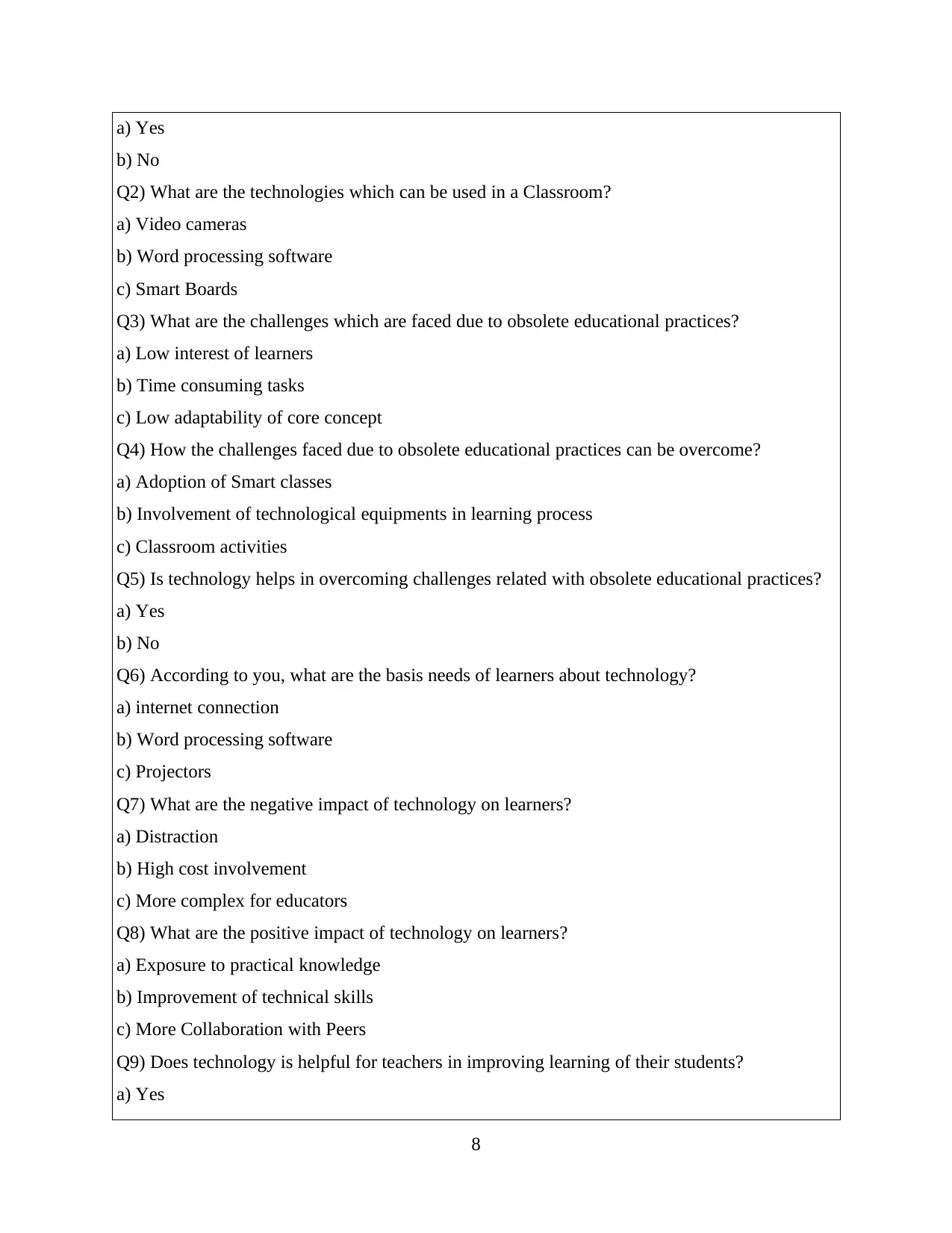
a) Yes
b) No
Q2) What are the technologies which can be used in a Classroom?
a) Video cameras
b) Word processing software
c) Smart Boards
Q3) What are the challenges which are faced due to obsolete educational practices?
a) Low interest of learners
b) Time consuming tasks
c) Low adaptability of core concept
Q4) How the challenges faced due to obsolete educational practices can be overcome?
a) Adoption of Smart classes
b) Involvement of technological equipments in learning process
c) Classroom activities
Q5) Is technology helps in overcoming challenges related with obsolete educational practices?
a) Yes
b) No
Q6) According to you, what are the basis needs of learners about technology?
a) internet connection
b) Word processing software
c) Projectors
Q7) What are the negative impact of technology on learners?
a) Distraction
b) High cost involvement
c) More complex for educators
Q8) What are the positive impact of technology on learners?
a) Exposure to practical knowledge
b) Improvement of technical skills
c) More Collaboration with Peers
Q9) Does technology is helpful for teachers in improving learning of their students?
a) Yes
8
b) No
Q2) What are the technologies which can be used in a Classroom?
a) Video cameras
b) Word processing software
c) Smart Boards
Q3) What are the challenges which are faced due to obsolete educational practices?
a) Low interest of learners
b) Time consuming tasks
c) Low adaptability of core concept
Q4) How the challenges faced due to obsolete educational practices can be overcome?
a) Adoption of Smart classes
b) Involvement of technological equipments in learning process
c) Classroom activities
Q5) Is technology helps in overcoming challenges related with obsolete educational practices?
a) Yes
b) No
Q6) According to you, what are the basis needs of learners about technology?
a) internet connection
b) Word processing software
c) Projectors
Q7) What are the negative impact of technology on learners?
a) Distraction
b) High cost involvement
c) More complex for educators
Q8) What are the positive impact of technology on learners?
a) Exposure to practical knowledge
b) Improvement of technical skills
c) More Collaboration with Peers
Q9) Does technology is helpful for teachers in improving learning of their students?
a) Yes
8
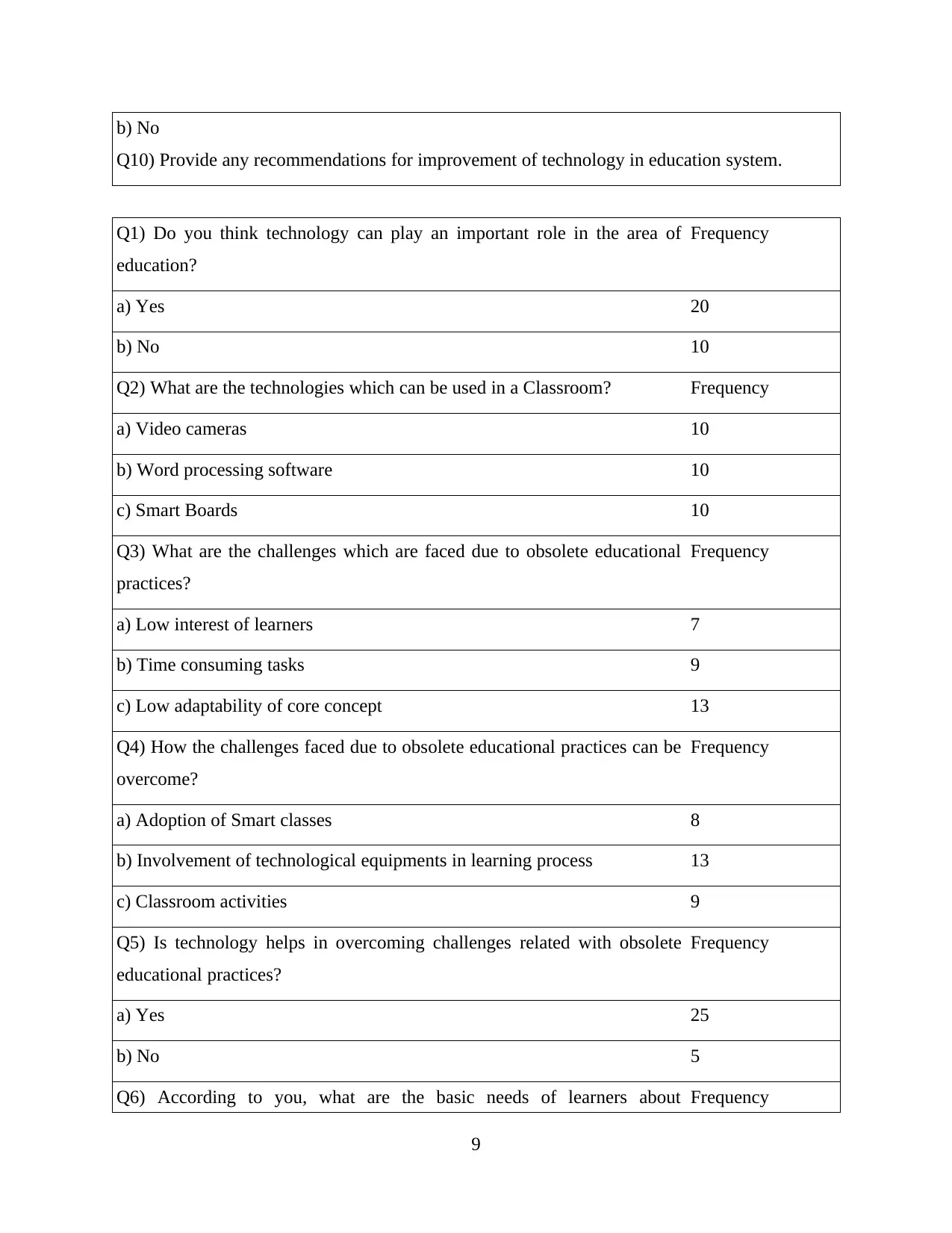
b) No
Q10) Provide any recommendations for improvement of technology in education system.
Q1) Do you think technology can play an important role in the area of
education?
Frequency
a) Yes 20
b) No 10
Q2) What are the technologies which can be used in a Classroom? Frequency
a) Video cameras 10
b) Word processing software 10
c) Smart Boards 10
Q3) What are the challenges which are faced due to obsolete educational
practices?
Frequency
a) Low interest of learners 7
b) Time consuming tasks 9
c) Low adaptability of core concept 13
Q4) How the challenges faced due to obsolete educational practices can be
overcome?
Frequency
a) Adoption of Smart classes 8
b) Involvement of technological equipments in learning process 13
c) Classroom activities 9
Q5) Is technology helps in overcoming challenges related with obsolete
educational practices?
Frequency
a) Yes 25
b) No 5
Q6) According to you, what are the basic needs of learners about Frequency
9
Q10) Provide any recommendations for improvement of technology in education system.
Q1) Do you think technology can play an important role in the area of
education?
Frequency
a) Yes 20
b) No 10
Q2) What are the technologies which can be used in a Classroom? Frequency
a) Video cameras 10
b) Word processing software 10
c) Smart Boards 10
Q3) What are the challenges which are faced due to obsolete educational
practices?
Frequency
a) Low interest of learners 7
b) Time consuming tasks 9
c) Low adaptability of core concept 13
Q4) How the challenges faced due to obsolete educational practices can be
overcome?
Frequency
a) Adoption of Smart classes 8
b) Involvement of technological equipments in learning process 13
c) Classroom activities 9
Q5) Is technology helps in overcoming challenges related with obsolete
educational practices?
Frequency
a) Yes 25
b) No 5
Q6) According to you, what are the basic needs of learners about Frequency
9
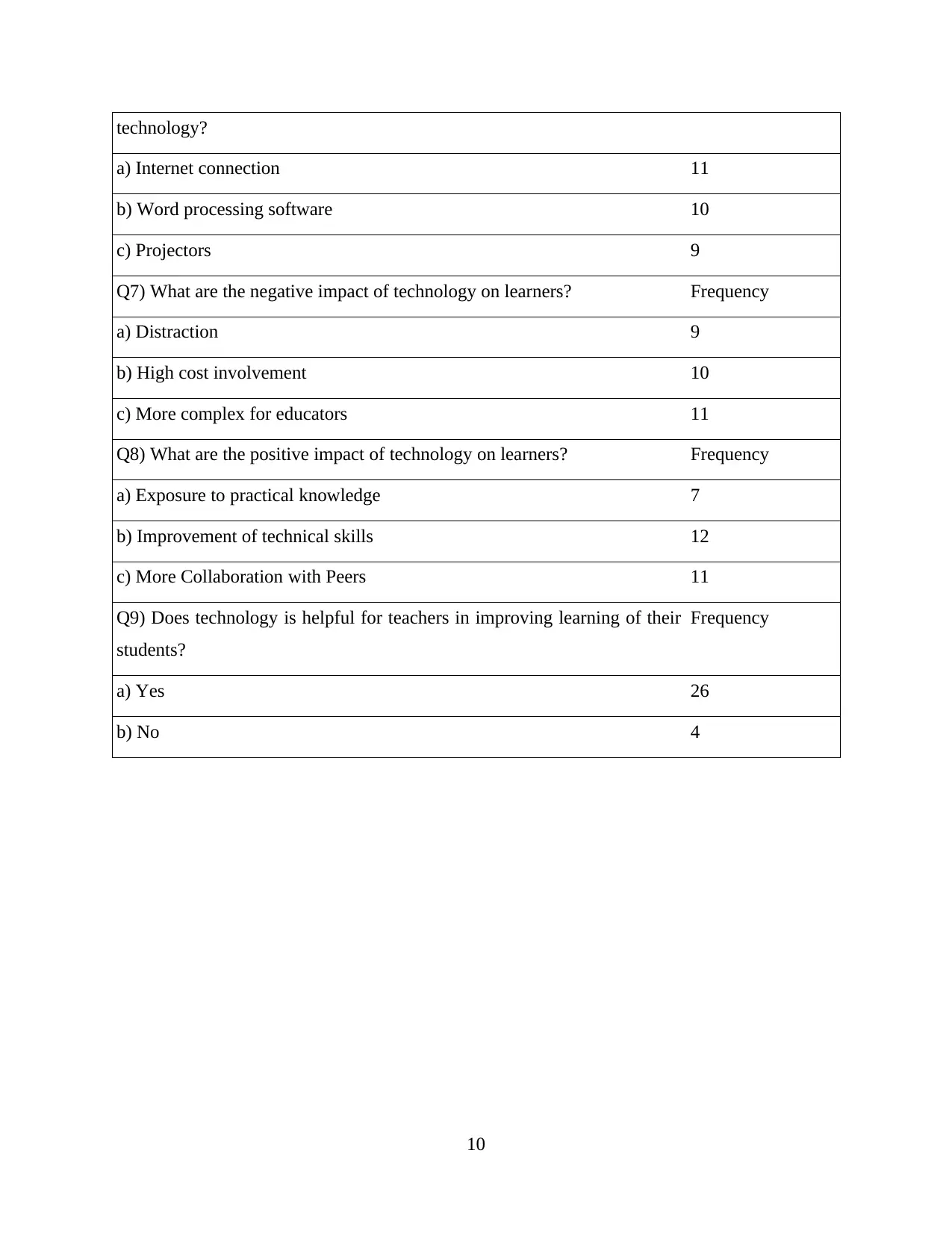
technology?
a) Internet connection 11
b) Word processing software 10
c) Projectors 9
Q7) What are the negative impact of technology on learners? Frequency
a) Distraction 9
b) High cost involvement 10
c) More complex for educators 11
Q8) What are the positive impact of technology on learners? Frequency
a) Exposure to practical knowledge 7
b) Improvement of technical skills 12
c) More Collaboration with Peers 11
Q9) Does technology is helpful for teachers in improving learning of their
students?
Frequency
a) Yes 26
b) No 4
10
a) Internet connection 11
b) Word processing software 10
c) Projectors 9
Q7) What are the negative impact of technology on learners? Frequency
a) Distraction 9
b) High cost involvement 10
c) More complex for educators 11
Q8) What are the positive impact of technology on learners? Frequency
a) Exposure to practical knowledge 7
b) Improvement of technical skills 12
c) More Collaboration with Peers 11
Q9) Does technology is helpful for teachers in improving learning of their
students?
Frequency
a) Yes 26
b) No 4
10
Paraphrase This Document
Need a fresh take? Get an instant paraphrase of this document with our AI Paraphraser
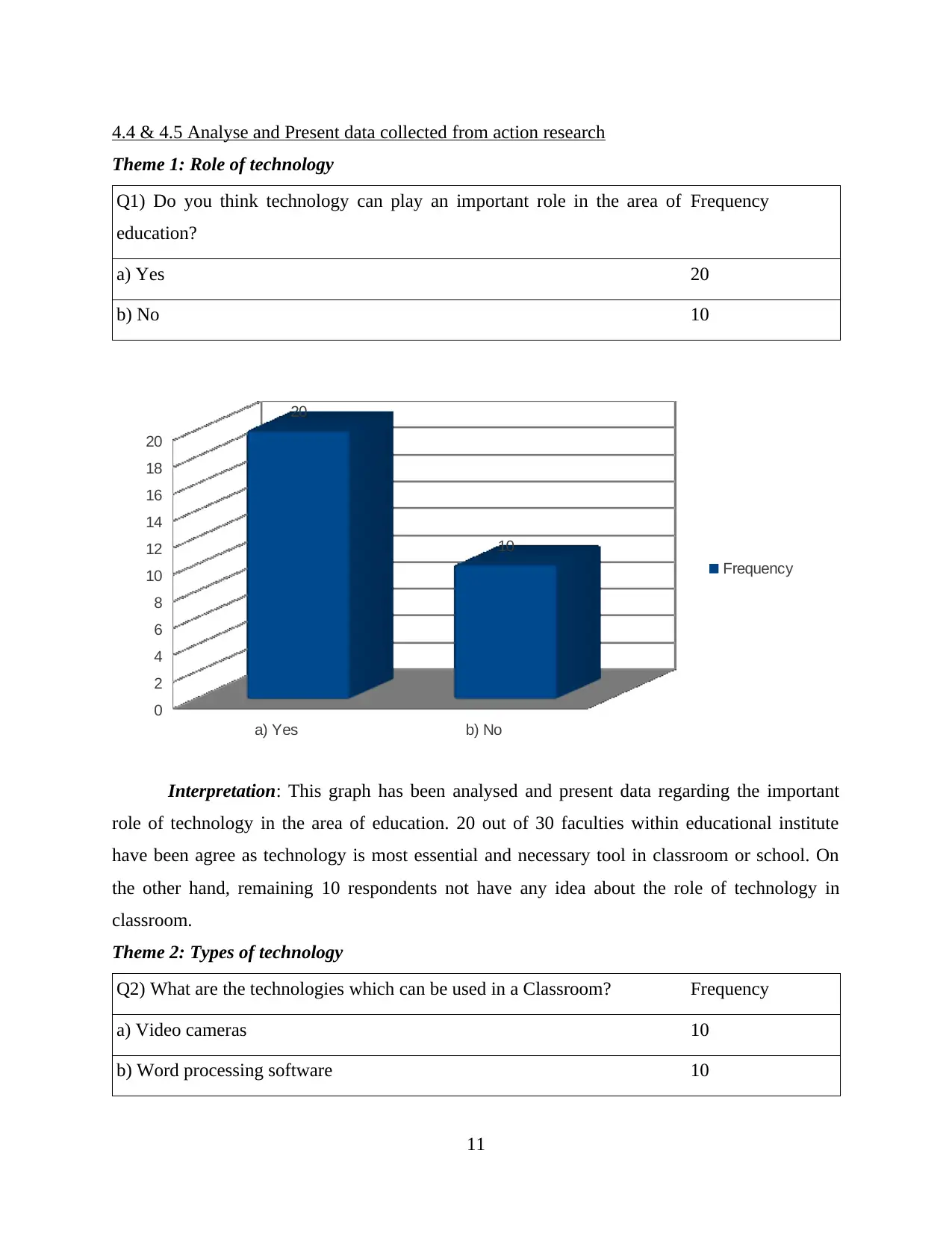
4.4 & 4.5 Analyse and Present data collected from action research
Theme 1: Role of technology
Q1) Do you think technology can play an important role in the area of
education?
Frequency
a) Yes 20
b) No 10
a) Yes b) No
0
2
4
6
8
10
12
14
16
18
20
20
10
Frequency
Interpretation: This graph has been analysed and present data regarding the important
role of technology in the area of education. 20 out of 30 faculties within educational institute
have been agree as technology is most essential and necessary tool in classroom or school. On
the other hand, remaining 10 respondents not have any idea about the role of technology in
classroom.
Theme 2: Types of technology
Q2) What are the technologies which can be used in a Classroom? Frequency
a) Video cameras 10
b) Word processing software 10
11
Theme 1: Role of technology
Q1) Do you think technology can play an important role in the area of
education?
Frequency
a) Yes 20
b) No 10
a) Yes b) No
0
2
4
6
8
10
12
14
16
18
20
20
10
Frequency
Interpretation: This graph has been analysed and present data regarding the important
role of technology in the area of education. 20 out of 30 faculties within educational institute
have been agree as technology is most essential and necessary tool in classroom or school. On
the other hand, remaining 10 respondents not have any idea about the role of technology in
classroom.
Theme 2: Types of technology
Q2) What are the technologies which can be used in a Classroom? Frequency
a) Video cameras 10
b) Word processing software 10
11

Q2) What are the technologies which can be used in a Classroom? Frequency
c) Smart Boards 10
a) Video cameras
b) Word processing software
c) Smart Boards
0
1
2
3
4
5
6
7
8
9
10
10 10 10
Frequency
Interpretation: It has been concluded types of technology which is require in classroom.
Respondents have equal opinion about the different types of technology which are needed in
education institutes such as video cameraes, smart boards and word processing software. All
these are necessary and useful technology in schools which will help learners by improving its
practical and technical skills.
Theme 3: Challenges faced due to obsolete educational practices
Q3) What are the challenges which are faced due to obsolete educational
practices?
Frequency
a) Low interest of learners 7
b) Time consuming tasks 9
c) Low adaptability of core concept 13
12
c) Smart Boards 10
a) Video cameras
b) Word processing software
c) Smart Boards
0
1
2
3
4
5
6
7
8
9
10
10 10 10
Frequency
Interpretation: It has been concluded types of technology which is require in classroom.
Respondents have equal opinion about the different types of technology which are needed in
education institutes such as video cameraes, smart boards and word processing software. All
these are necessary and useful technology in schools which will help learners by improving its
practical and technical skills.
Theme 3: Challenges faced due to obsolete educational practices
Q3) What are the challenges which are faced due to obsolete educational
practices?
Frequency
a) Low interest of learners 7
b) Time consuming tasks 9
c) Low adaptability of core concept 13
12
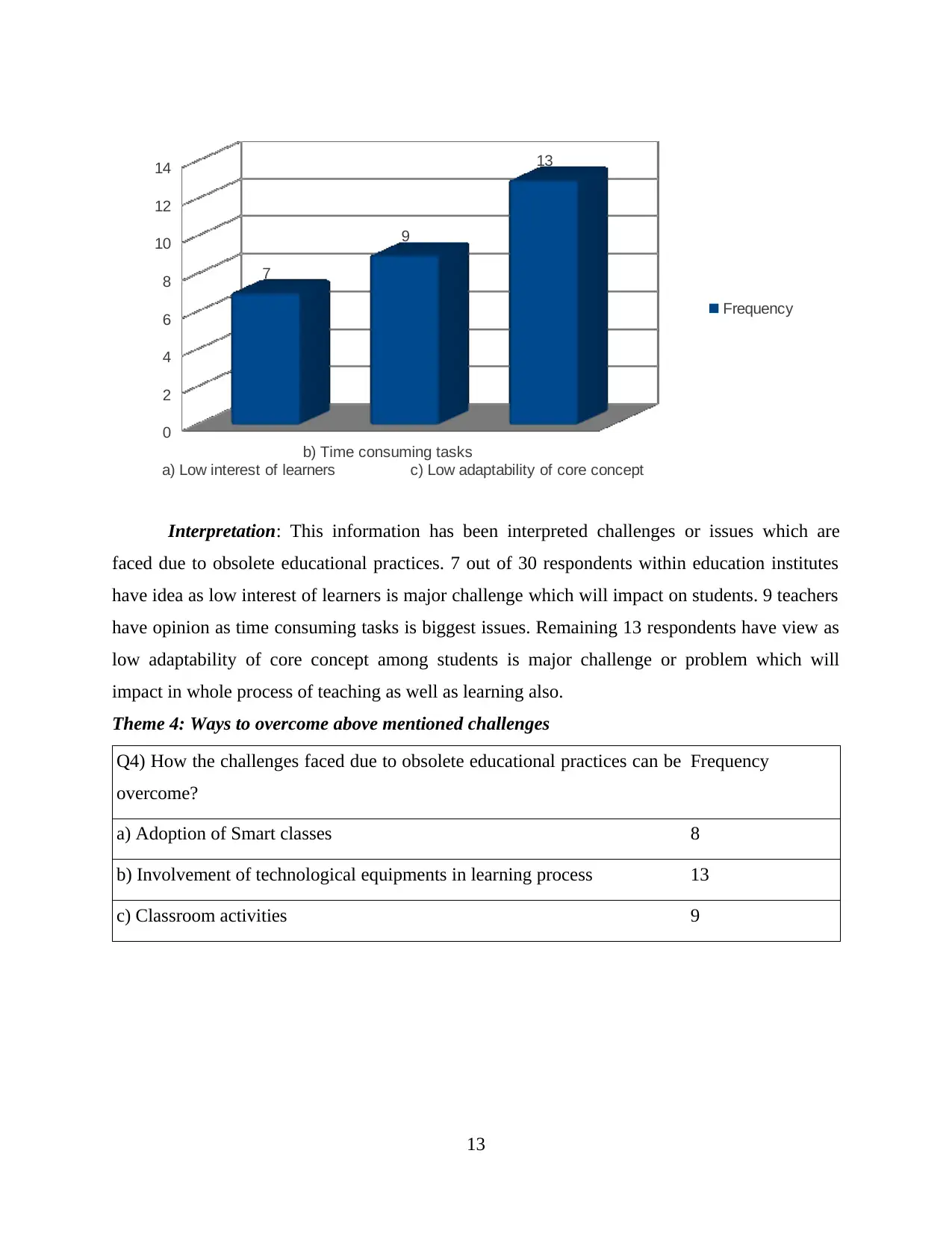
a) Low interest of learners
b) Time consuming tasks
c) Low adaptability of core concept
0
2
4
6
8
10
12
14
7
9
13
Frequency
Interpretation: This information has been interpreted challenges or issues which are
faced due to obsolete educational practices. 7 out of 30 respondents within education institutes
have idea as low interest of learners is major challenge which will impact on students. 9 teachers
have opinion as time consuming tasks is biggest issues. Remaining 13 respondents have view as
low adaptability of core concept among students is major challenge or problem which will
impact in whole process of teaching as well as learning also.
Theme 4: Ways to overcome above mentioned challenges
Q4) How the challenges faced due to obsolete educational practices can be
overcome?
Frequency
a) Adoption of Smart classes 8
b) Involvement of technological equipments in learning process 13
c) Classroom activities 9
13
b) Time consuming tasks
c) Low adaptability of core concept
0
2
4
6
8
10
12
14
7
9
13
Frequency
Interpretation: This information has been interpreted challenges or issues which are
faced due to obsolete educational practices. 7 out of 30 respondents within education institutes
have idea as low interest of learners is major challenge which will impact on students. 9 teachers
have opinion as time consuming tasks is biggest issues. Remaining 13 respondents have view as
low adaptability of core concept among students is major challenge or problem which will
impact in whole process of teaching as well as learning also.
Theme 4: Ways to overcome above mentioned challenges
Q4) How the challenges faced due to obsolete educational practices can be
overcome?
Frequency
a) Adoption of Smart classes 8
b) Involvement of technological equipments in learning process 13
c) Classroom activities 9
13
Secure Best Marks with AI Grader
Need help grading? Try our AI Grader for instant feedback on your assignments.
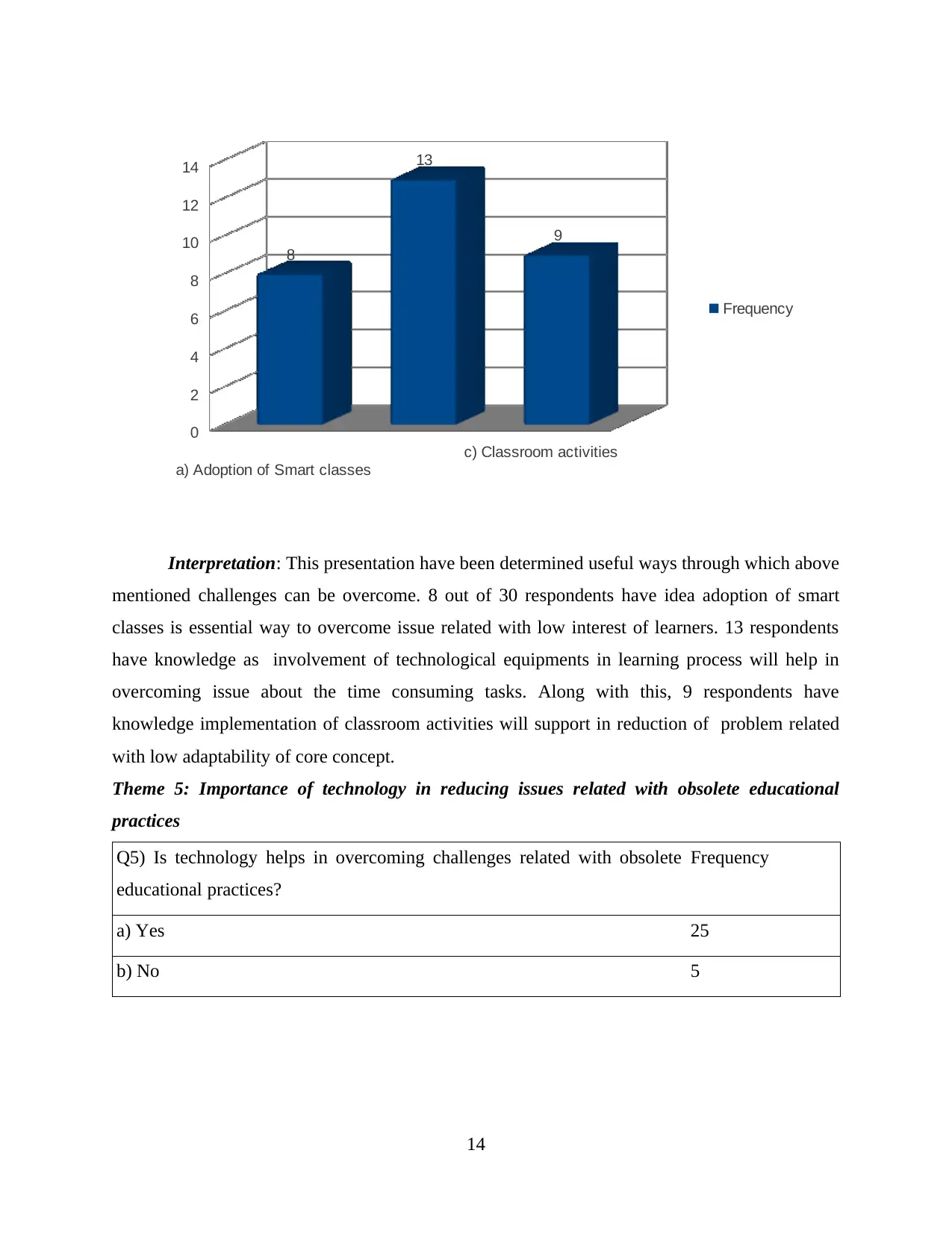
a) Adoption of Smart classes
c) Classroom activities
0
2
4
6
8
10
12
14
8
13
9
Frequency
Interpretation: This presentation have been determined useful ways through which above
mentioned challenges can be overcome. 8 out of 30 respondents have idea adoption of smart
classes is essential way to overcome issue related with low interest of learners. 13 respondents
have knowledge as involvement of technological equipments in learning process will help in
overcoming issue about the time consuming tasks. Along with this, 9 respondents have
knowledge implementation of classroom activities will support in reduction of problem related
with low adaptability of core concept.
Theme 5: Importance of technology in reducing issues related with obsolete educational
practices
Q5) Is technology helps in overcoming challenges related with obsolete
educational practices?
Frequency
a) Yes 25
b) No 5
14
c) Classroom activities
0
2
4
6
8
10
12
14
8
13
9
Frequency
Interpretation: This presentation have been determined useful ways through which above
mentioned challenges can be overcome. 8 out of 30 respondents have idea adoption of smart
classes is essential way to overcome issue related with low interest of learners. 13 respondents
have knowledge as involvement of technological equipments in learning process will help in
overcoming issue about the time consuming tasks. Along with this, 9 respondents have
knowledge implementation of classroom activities will support in reduction of problem related
with low adaptability of core concept.
Theme 5: Importance of technology in reducing issues related with obsolete educational
practices
Q5) Is technology helps in overcoming challenges related with obsolete
educational practices?
Frequency
a) Yes 25
b) No 5
14

a) Yes b) No
0
5
10
15
20
25
25
5
Frequency
Interpretation: This chart has been concluded effectiveness of technology equipments in
overcoming problems related with obsolete educational practices. 25 out of 30 faculties within
educational institutes have been agree about such concept whereas remaining 5 respondents not
agree regarding the same.
Theme 6: Basic needs of learners about technology
Q6) According to you, what are the basic needs of learners about
technology?
Frequency
a) Internet connection 11
b) Word processing software 10
c) Projectors 9
15
0
5
10
15
20
25
25
5
Frequency
Interpretation: This chart has been concluded effectiveness of technology equipments in
overcoming problems related with obsolete educational practices. 25 out of 30 faculties within
educational institutes have been agree about such concept whereas remaining 5 respondents not
agree regarding the same.
Theme 6: Basic needs of learners about technology
Q6) According to you, what are the basic needs of learners about
technology?
Frequency
a) Internet connection 11
b) Word processing software 10
c) Projectors 9
15

a) Internet connection
b) Word processing software
c) Projectors
0
2
4
6
8
10
12 11
10
9
Frequency
Interpretation: This graph mainly related with needs of learners about technology. 11
respondents have knowledge as internet connection is main requirement of learner. 10
respondents have idea as word processing software is major requirement of learner within
classroom. Remaining 9 respondents have opinion as projectors in classroom or school is main
need which will help the learners by improving its technical as well as practical knowledge about
the specific area.
Theme 7: Negative impact of technology on learners
Q7) What are the negative impact of technology on learners? Frequency
a) Distraction 9
b) High cost involvement 10
c) More complex for educators 11
16
b) Word processing software
c) Projectors
0
2
4
6
8
10
12 11
10
9
Frequency
Interpretation: This graph mainly related with needs of learners about technology. 11
respondents have knowledge as internet connection is main requirement of learner. 10
respondents have idea as word processing software is major requirement of learner within
classroom. Remaining 9 respondents have opinion as projectors in classroom or school is main
need which will help the learners by improving its technical as well as practical knowledge about
the specific area.
Theme 7: Negative impact of technology on learners
Q7) What are the negative impact of technology on learners? Frequency
a) Distraction 9
b) High cost involvement 10
c) More complex for educators 11
16
Paraphrase This Document
Need a fresh take? Get an instant paraphrase of this document with our AI Paraphraser

a) Distraction
b) High cost involvement
c) More complex for educators
0
2
4
6
8
10
12
9
10
11
Frequency
Interpretation: From the above stated information that defined unfavourable effects of
technology on students. 9 out of 30 respondents have idea as sometime technology increase
distraction among learners. 10 participants have idea as in usage of technology, maximum
amount of capital will be require. Remaining 11 respondents have opinion as implementation of
technology is more complex for educators.
Theme 8: Positive impact of technology on learners
Q8) What are the positive impact of technology on learners? Frequency
a) Exposure to practical knowledge 7
b) Improvement of technical skills 12
c) More Collaboration with Peers 11
17
b) High cost involvement
c) More complex for educators
0
2
4
6
8
10
12
9
10
11
Frequency
Interpretation: From the above stated information that defined unfavourable effects of
technology on students. 9 out of 30 respondents have idea as sometime technology increase
distraction among learners. 10 participants have idea as in usage of technology, maximum
amount of capital will be require. Remaining 11 respondents have opinion as implementation of
technology is more complex for educators.
Theme 8: Positive impact of technology on learners
Q8) What are the positive impact of technology on learners? Frequency
a) Exposure to practical knowledge 7
b) Improvement of technical skills 12
c) More Collaboration with Peers 11
17

a) Exposure to practical knowledge
c) More Collaboration with Peers
0
2
4
6
8
10
12
7
12
11
Frequency
Interpretation: It has been determined positive effect of technology on students within
educational institutes. 7 out of 30 faculties have idea as technology helps the learner to exposure
their practical knowledge. 12 respondents have knowledge as technology is most essential and
effective for learners because it will help them in improving its technical skills. Remaining 11
respondents have view as technology also support in more Collaboration with Peers. Thus, all
these are identified main advantages of technology for learners in schools which will helps in its
growth and success.
Theme 9: Effectiveness of technology for teachers
Q9) Does technology is helpful for teachers in improving learning of their
students?
Frequency
a) Yes 26
b) No 4
18
c) More Collaboration with Peers
0
2
4
6
8
10
12
7
12
11
Frequency
Interpretation: It has been determined positive effect of technology on students within
educational institutes. 7 out of 30 faculties have idea as technology helps the learner to exposure
their practical knowledge. 12 respondents have knowledge as technology is most essential and
effective for learners because it will help them in improving its technical skills. Remaining 11
respondents have view as technology also support in more Collaboration with Peers. Thus, all
these are identified main advantages of technology for learners in schools which will helps in its
growth and success.
Theme 9: Effectiveness of technology for teachers
Q9) Does technology is helpful for teachers in improving learning of their
students?
Frequency
a) Yes 26
b) No 4
18
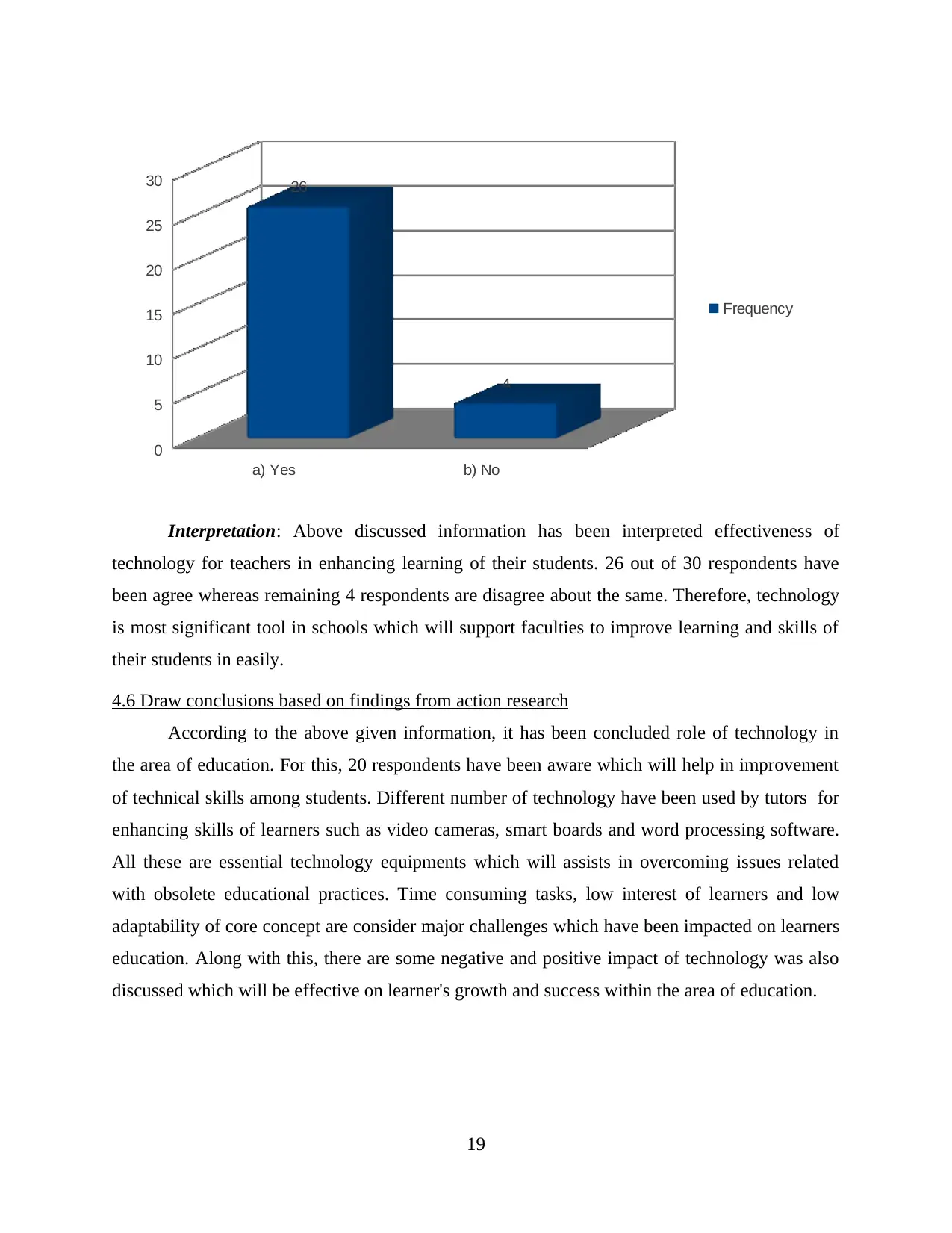
a) Yes b) No
0
5
10
15
20
25
30 26
4
Frequency
Interpretation: Above discussed information has been interpreted effectiveness of
technology for teachers in enhancing learning of their students. 26 out of 30 respondents have
been agree whereas remaining 4 respondents are disagree about the same. Therefore, technology
is most significant tool in schools which will support faculties to improve learning and skills of
their students in easily.
4.6 Draw conclusions based on findings from action research
According to the above given information, it has been concluded role of technology in
the area of education. For this, 20 respondents have been aware which will help in improvement
of technical skills among students. Different number of technology have been used by tutors for
enhancing skills of learners such as video cameras, smart boards and word processing software.
All these are essential technology equipments which will assists in overcoming issues related
with obsolete educational practices. Time consuming tasks, low interest of learners and low
adaptability of core concept are consider major challenges which have been impacted on learners
education. Along with this, there are some negative and positive impact of technology was also
discussed which will be effective on learner's growth and success within the area of education.
19
0
5
10
15
20
25
30 26
4
Frequency
Interpretation: Above discussed information has been interpreted effectiveness of
technology for teachers in enhancing learning of their students. 26 out of 30 respondents have
been agree whereas remaining 4 respondents are disagree about the same. Therefore, technology
is most significant tool in schools which will support faculties to improve learning and skills of
their students in easily.
4.6 Draw conclusions based on findings from action research
According to the above given information, it has been concluded role of technology in
the area of education. For this, 20 respondents have been aware which will help in improvement
of technical skills among students. Different number of technology have been used by tutors for
enhancing skills of learners such as video cameras, smart boards and word processing software.
All these are essential technology equipments which will assists in overcoming issues related
with obsolete educational practices. Time consuming tasks, low interest of learners and low
adaptability of core concept are consider major challenges which have been impacted on learners
education. Along with this, there are some negative and positive impact of technology was also
discussed which will be effective on learner's growth and success within the area of education.
19
Secure Best Marks with AI Grader
Need help grading? Try our AI Grader for instant feedback on your assignments.

TASK 5
5.1 Report own findings and conclusions from action research
By performing each activities or tasks of action research I am able to find out
requirement for developing technology in schools or classroom. I have to used different methods
for completing action research within given time period. Along with this, I have to used
questionnaire for accumulating reliable and valid information about the study. I am able to
analysis importance of technology in educational institutes and its impact on students as well as
faculties success (Waite, 2017). Action research help me in improving my different skills such as
communication, time management etc. These skills will support me in performing each tasks of
project in systematic and effective manner.
5.2 Justify own recommendations for action to be taken based on conclusions from action
research
From the above mentioned data it has been recommended effectiveness of technology in
classroom. Different number of negative impact of technology have been determined such as
distraction, high cost involvement and more complex for educators. All these are major issues
which is found by me while collecting data from the respondents (Zainuddin and Halili, 2016).
Along with this, there are various challenges which have been faced by learners due to obsolete
educational practices such as low interest, time consuming tasks and low adaptability of core
concept. In order to overcome these challenges some recommendation have been provided to
educational institutes which are determined as under:
Educational institutes must adopt smart classes which will help in increasing interest of
learners about the education.
Involvement of technological equipments in learning process is also identify most
essential and effective way for improving different types of skills among students such as
practical, technical etc.
Institutes should conduct different activities in classroom which will help them in
overcoming issues of low adaptability of core concept and time consuming task.
20
5.1 Report own findings and conclusions from action research
By performing each activities or tasks of action research I am able to find out
requirement for developing technology in schools or classroom. I have to used different methods
for completing action research within given time period. Along with this, I have to used
questionnaire for accumulating reliable and valid information about the study. I am able to
analysis importance of technology in educational institutes and its impact on students as well as
faculties success (Waite, 2017). Action research help me in improving my different skills such as
communication, time management etc. These skills will support me in performing each tasks of
project in systematic and effective manner.
5.2 Justify own recommendations for action to be taken based on conclusions from action
research
From the above mentioned data it has been recommended effectiveness of technology in
classroom. Different number of negative impact of technology have been determined such as
distraction, high cost involvement and more complex for educators. All these are major issues
which is found by me while collecting data from the respondents (Zainuddin and Halili, 2016).
Along with this, there are various challenges which have been faced by learners due to obsolete
educational practices such as low interest, time consuming tasks and low adaptability of core
concept. In order to overcome these challenges some recommendation have been provided to
educational institutes which are determined as under:
Educational institutes must adopt smart classes which will help in increasing interest of
learners about the education.
Involvement of technological equipments in learning process is also identify most
essential and effective way for improving different types of skills among students such as
practical, technical etc.
Institutes should conduct different activities in classroom which will help them in
overcoming issues of low adaptability of core concept and time consuming task.
20
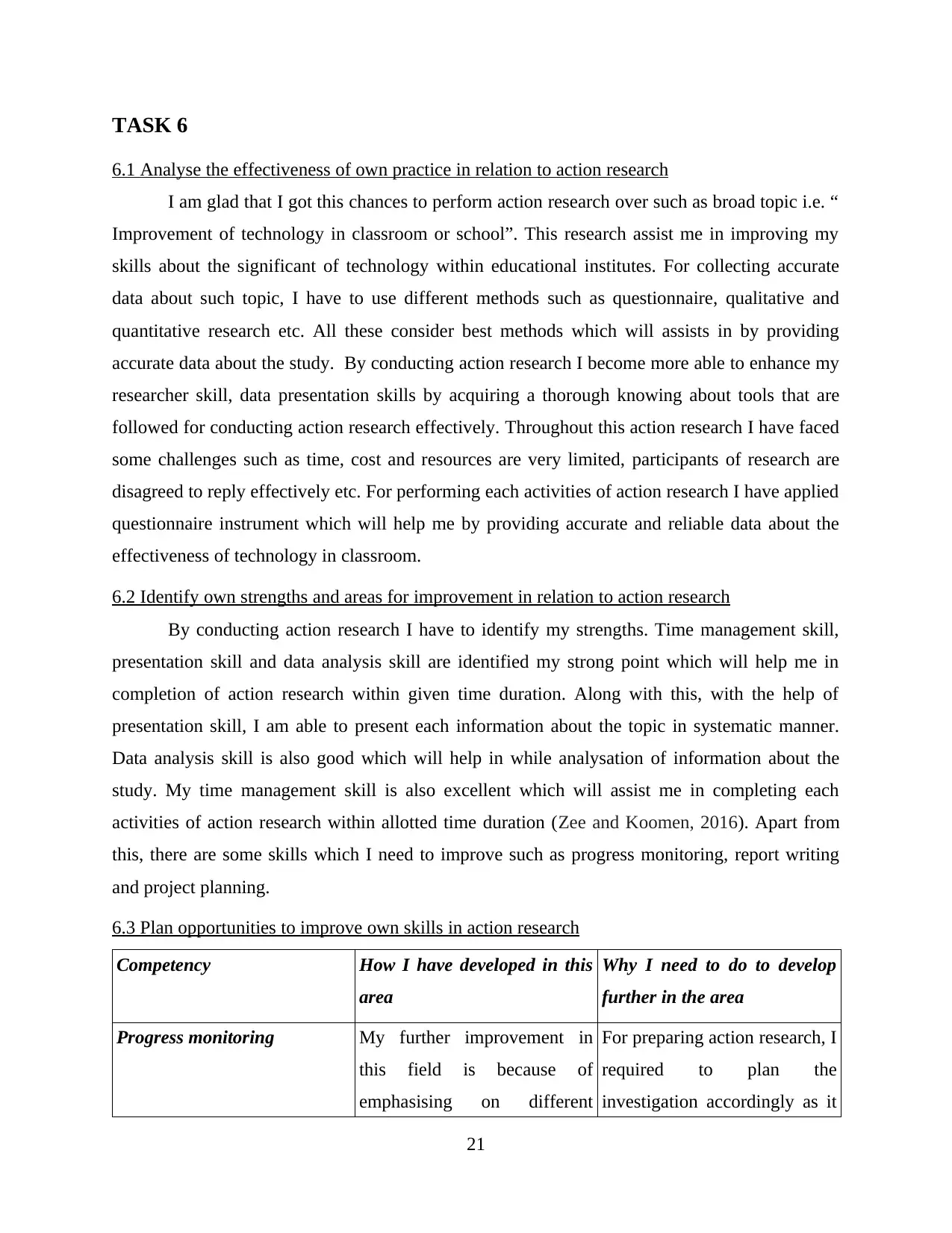
TASK 6
6.1 Analyse the effectiveness of own practice in relation to action research
I am glad that I got this chances to perform action research over such as broad topic i.e. “
Improvement of technology in classroom or school”. This research assist me in improving my
skills about the significant of technology within educational institutes. For collecting accurate
data about such topic, I have to use different methods such as questionnaire, qualitative and
quantitative research etc. All these consider best methods which will assists in by providing
accurate data about the study. By conducting action research I become more able to enhance my
researcher skill, data presentation skills by acquiring a thorough knowing about tools that are
followed for conducting action research effectively. Throughout this action research I have faced
some challenges such as time, cost and resources are very limited, participants of research are
disagreed to reply effectively etc. For performing each activities of action research I have applied
questionnaire instrument which will help me by providing accurate and reliable data about the
effectiveness of technology in classroom.
6.2 Identify own strengths and areas for improvement in relation to action research
By conducting action research I have to identify my strengths. Time management skill,
presentation skill and data analysis skill are identified my strong point which will help me in
completion of action research within given time duration. Along with this, with the help of
presentation skill, I am able to present each information about the topic in systematic manner.
Data analysis skill is also good which will help in while analysation of information about the
study. My time management skill is also excellent which will assist me in completing each
activities of action research within allotted time duration (Zee and Koomen, 2016). Apart from
this, there are some skills which I need to improve such as progress monitoring, report writing
and project planning.
6.3 Plan opportunities to improve own skills in action research
Competency How I have developed in this
area
Why I need to do to develop
further in the area
Progress monitoring My further improvement in
this field is because of
emphasising on different
For preparing action research, I
required to plan the
investigation accordingly as it
21
6.1 Analyse the effectiveness of own practice in relation to action research
I am glad that I got this chances to perform action research over such as broad topic i.e. “
Improvement of technology in classroom or school”. This research assist me in improving my
skills about the significant of technology within educational institutes. For collecting accurate
data about such topic, I have to use different methods such as questionnaire, qualitative and
quantitative research etc. All these consider best methods which will assists in by providing
accurate data about the study. By conducting action research I become more able to enhance my
researcher skill, data presentation skills by acquiring a thorough knowing about tools that are
followed for conducting action research effectively. Throughout this action research I have faced
some challenges such as time, cost and resources are very limited, participants of research are
disagreed to reply effectively etc. For performing each activities of action research I have applied
questionnaire instrument which will help me by providing accurate and reliable data about the
effectiveness of technology in classroom.
6.2 Identify own strengths and areas for improvement in relation to action research
By conducting action research I have to identify my strengths. Time management skill,
presentation skill and data analysis skill are identified my strong point which will help me in
completion of action research within given time duration. Along with this, with the help of
presentation skill, I am able to present each information about the topic in systematic manner.
Data analysis skill is also good which will help in while analysation of information about the
study. My time management skill is also excellent which will assist me in completing each
activities of action research within allotted time duration (Zee and Koomen, 2016). Apart from
this, there are some skills which I need to improve such as progress monitoring, report writing
and project planning.
6.3 Plan opportunities to improve own skills in action research
Competency How I have developed in this
area
Why I need to do to develop
further in the area
Progress monitoring My further improvement in
this field is because of
emphasising on different
For preparing action research, I
required to plan the
investigation accordingly as it
21

number of aspects of my living
like proper communication,
already implanted institutes's
goals.
will directly support me in
completing action
investigation in efficient time.
Report writing In this area, I joined some
classes, meetup, workshops as
well as also took writing class
for further improvement of
myself.
While writing essential
information or data, my
knowledge must be better. So
my development is needed in
order to write well.
Project planning. For improvement in this area I
attend different classes. Also I
followed different seminars as
well as conferences for
watching my progress.
For controlling and watching
the development of my team
work, I necessity to follow my
progress monitoring skills.
CONCLUSION
From the above given information, it has been concluded technology is necessary and
essential part in Classroom. As it will help in improving different skills of learners such as
practical, technical etc. These skills will help them in development of its growth and success
easily. Along with this, action research will also support in improving learners skills by
implementing technology within classroom.
22
like proper communication,
already implanted institutes's
goals.
will directly support me in
completing action
investigation in efficient time.
Report writing In this area, I joined some
classes, meetup, workshops as
well as also took writing class
for further improvement of
myself.
While writing essential
information or data, my
knowledge must be better. So
my development is needed in
order to write well.
Project planning. For improvement in this area I
attend different classes. Also I
followed different seminars as
well as conferences for
watching my progress.
For controlling and watching
the development of my team
work, I necessity to follow my
progress monitoring skills.
CONCLUSION
From the above given information, it has been concluded technology is necessary and
essential part in Classroom. As it will help in improving different skills of learners such as
practical, technical etc. These skills will help them in development of its growth and success
easily. Along with this, action research will also support in improving learners skills by
implementing technology within classroom.
22
Paraphrase This Document
Need a fresh take? Get an instant paraphrase of this document with our AI Paraphraser

REFERENCES
Books and Journals
Ahmad, F. K., 2015. Use of assistive technology in inclusive education: Making room for
diverse learning needs. Transcience. 6(2). pp.62-77.
Brahimi, T. and Sarirete, A., 2015. Learning outside the classroom through MOOCs. Computers
in Human Behavior. 51. pp.604-609.
Delgado, A. J. and et. al., 2015. Educational technology: A review of the integration, resources,
and effectiveness of technology in K-12 classrooms. Journal of Information Technology
Education. 14.
Hwang, G. J., Lai, C. L. and Wang, S. Y., 2015. Seamless flipped learning: a mobile technology-
enhanced flipped classroom with effective learning strategies. Journal of computers in
education. 2(4). pp.449-473.
John, P. and Wheeler, S., 2015. The digital classroom: Harnessing technology for the future of
learning and teaching. David Fulton Publishers.
Kayalar, F., 2016. Cross-Cultural Comparison of Teachers' Views upon Integration and Use of
Technology in Classroom. Turkish Online Journal of Educational Technology-TOJET.
15(2). pp.11-19.
Lai, C., 2015. Modeling teachers' influence on learners' self-directed use of technology for
language learning outside the classroom. Computers & Education. 82. pp.74-83.
Merç, A., 2015. Using technology in the classroom: A study with Turkish pre-service EFL
teachers. Turkish Online Journal of Educational Technology-TOJET.14(2). pp.229-240.
Moffett, J., 2015. Twelve tips for “flipping” the classroom. Medical teacher. 37(4). pp.331-336.
Mueller, P. A. and Oppenheimer, D. M., 2016. Technology and note-taking in the classroom,
boardroom, hospital room, and courtroom. Trends in Neuroscience and Education. 5(3).
pp.139-145.
Noble, D. D., 2017. The classroom arsenal: Military research, information technology and
public education. Routledge.
Nunan, D. and Richards, J. C. eds., 2015. Language learning beyond the classroom. Routledge.
Sharma, N. and et. al., 2015. How we flipped the medical classroom. Medical teacher. 37(4).
pp.327-330.
Thomas, K. and Muñoz, M. A., 2016. Hold the phone! High school students' perceptions of
mobile phone integration in the classroom. American Secondary Education. 44(3).
pp.19-37.
Waite, S. ed., 2017. Children learning outside the classroom: From birth to eleven. Sage.
Zainuddin, Z. and Halili, S., 2016. Flipped classroom research and trends from different fields of
study. The international review of research in open and distributed learning. 17(3).
Zee, M. and Koomen, H. M., 2016. Teacher self-efficacy and its effects on classroom processes,
student academic adjustment, and teacher well-being: A synthesis of 40 years of
research. Review of Educational research. 86(4). pp.981-1015.
Online
Jane Wakefield. 2015. Technology in schools: Future changes in classrooms. [online] Available
through; <https://www.bbc.com/news/technology-30814302>.
23
Books and Journals
Ahmad, F. K., 2015. Use of assistive technology in inclusive education: Making room for
diverse learning needs. Transcience. 6(2). pp.62-77.
Brahimi, T. and Sarirete, A., 2015. Learning outside the classroom through MOOCs. Computers
in Human Behavior. 51. pp.604-609.
Delgado, A. J. and et. al., 2015. Educational technology: A review of the integration, resources,
and effectiveness of technology in K-12 classrooms. Journal of Information Technology
Education. 14.
Hwang, G. J., Lai, C. L. and Wang, S. Y., 2015. Seamless flipped learning: a mobile technology-
enhanced flipped classroom with effective learning strategies. Journal of computers in
education. 2(4). pp.449-473.
John, P. and Wheeler, S., 2015. The digital classroom: Harnessing technology for the future of
learning and teaching. David Fulton Publishers.
Kayalar, F., 2016. Cross-Cultural Comparison of Teachers' Views upon Integration and Use of
Technology in Classroom. Turkish Online Journal of Educational Technology-TOJET.
15(2). pp.11-19.
Lai, C., 2015. Modeling teachers' influence on learners' self-directed use of technology for
language learning outside the classroom. Computers & Education. 82. pp.74-83.
Merç, A., 2015. Using technology in the classroom: A study with Turkish pre-service EFL
teachers. Turkish Online Journal of Educational Technology-TOJET.14(2). pp.229-240.
Moffett, J., 2015. Twelve tips for “flipping” the classroom. Medical teacher. 37(4). pp.331-336.
Mueller, P. A. and Oppenheimer, D. M., 2016. Technology and note-taking in the classroom,
boardroom, hospital room, and courtroom. Trends in Neuroscience and Education. 5(3).
pp.139-145.
Noble, D. D., 2017. The classroom arsenal: Military research, information technology and
public education. Routledge.
Nunan, D. and Richards, J. C. eds., 2015. Language learning beyond the classroom. Routledge.
Sharma, N. and et. al., 2015. How we flipped the medical classroom. Medical teacher. 37(4).
pp.327-330.
Thomas, K. and Muñoz, M. A., 2016. Hold the phone! High school students' perceptions of
mobile phone integration in the classroom. American Secondary Education. 44(3).
pp.19-37.
Waite, S. ed., 2017. Children learning outside the classroom: From birth to eleven. Sage.
Zainuddin, Z. and Halili, S., 2016. Flipped classroom research and trends from different fields of
study. The international review of research in open and distributed learning. 17(3).
Zee, M. and Koomen, H. M., 2016. Teacher self-efficacy and its effects on classroom processes,
student academic adjustment, and teacher well-being: A synthesis of 40 years of
research. Review of Educational research. 86(4). pp.981-1015.
Online
Jane Wakefield. 2015. Technology in schools: Future changes in classrooms. [online] Available
through; <https://www.bbc.com/news/technology-30814302>.
23
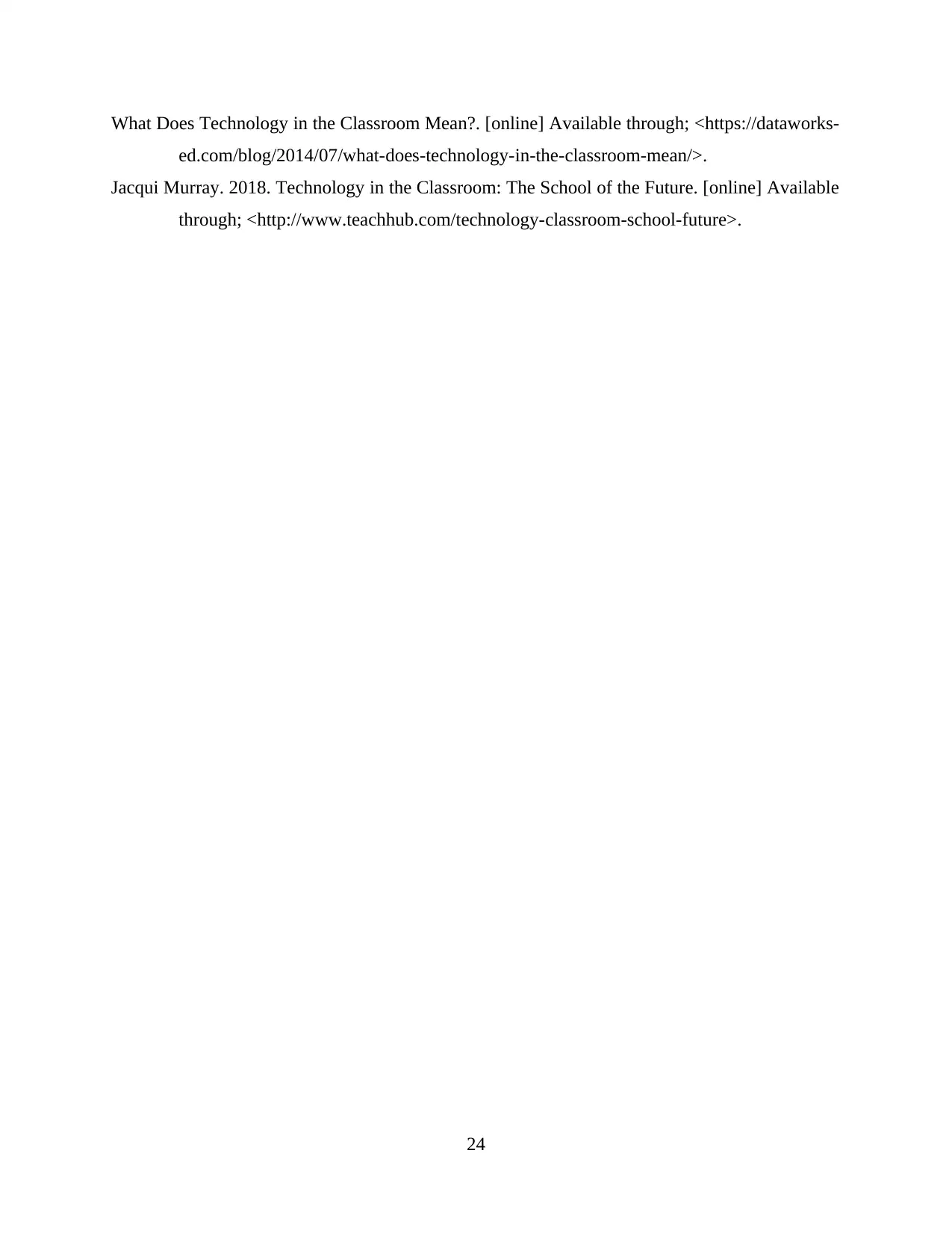
What Does Technology in the Classroom Mean?. [online] Available through; <https://dataworks-
ed.com/blog/2014/07/what-does-technology-in-the-classroom-mean/>.
Jacqui Murray. 2018. Technology in the Classroom: The School of the Future. [online] Available
through; <http://www.teachhub.com/technology-classroom-school-future>.
24
ed.com/blog/2014/07/what-does-technology-in-the-classroom-mean/>.
Jacqui Murray. 2018. Technology in the Classroom: The School of the Future. [online] Available
through; <http://www.teachhub.com/technology-classroom-school-future>.
24
1 out of 27
Related Documents
Your All-in-One AI-Powered Toolkit for Academic Success.
+13062052269
info@desklib.com
Available 24*7 on WhatsApp / Email
![[object Object]](/_next/static/media/star-bottom.7253800d.svg)
Unlock your academic potential
© 2024 | Zucol Services PVT LTD | All rights reserved.





